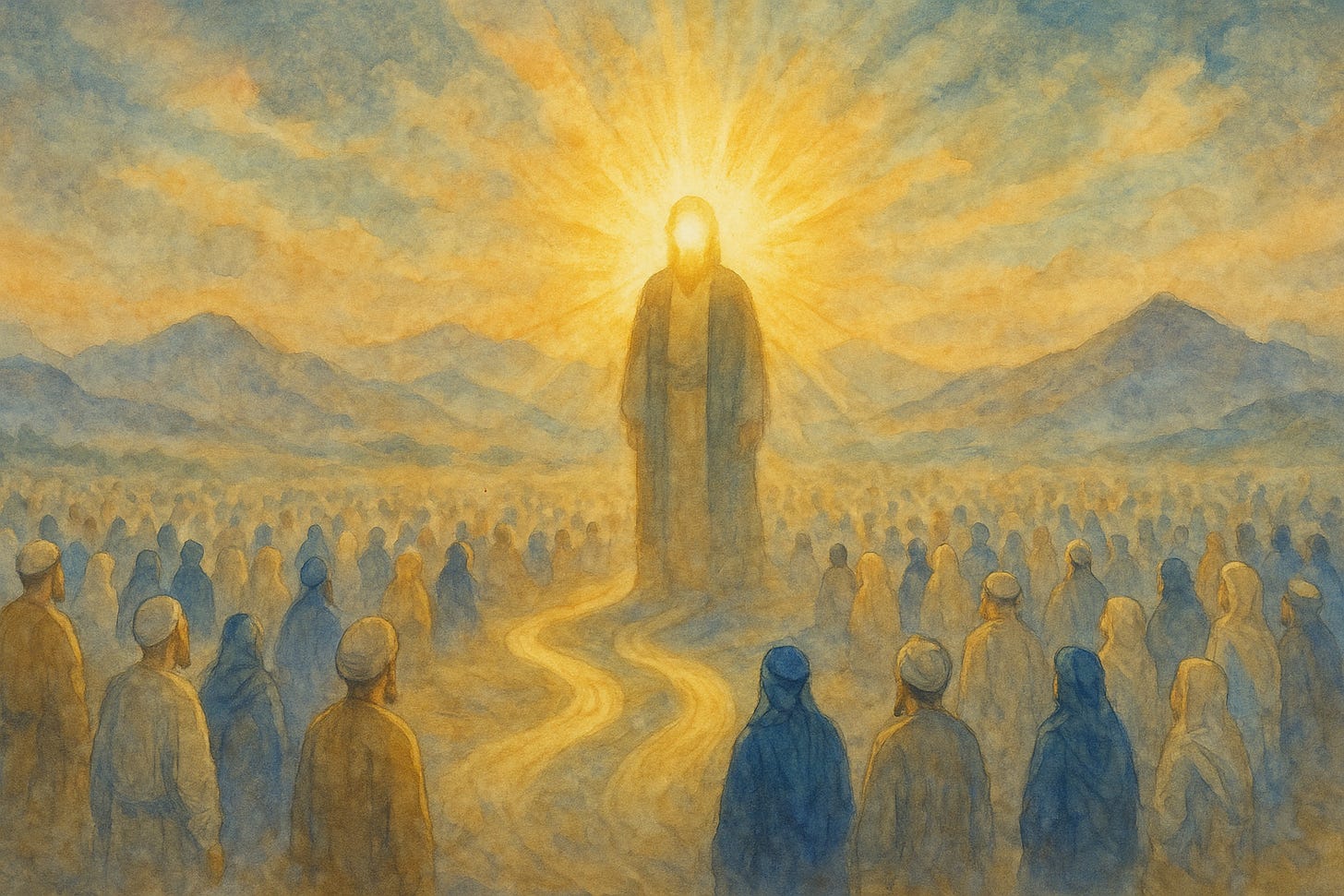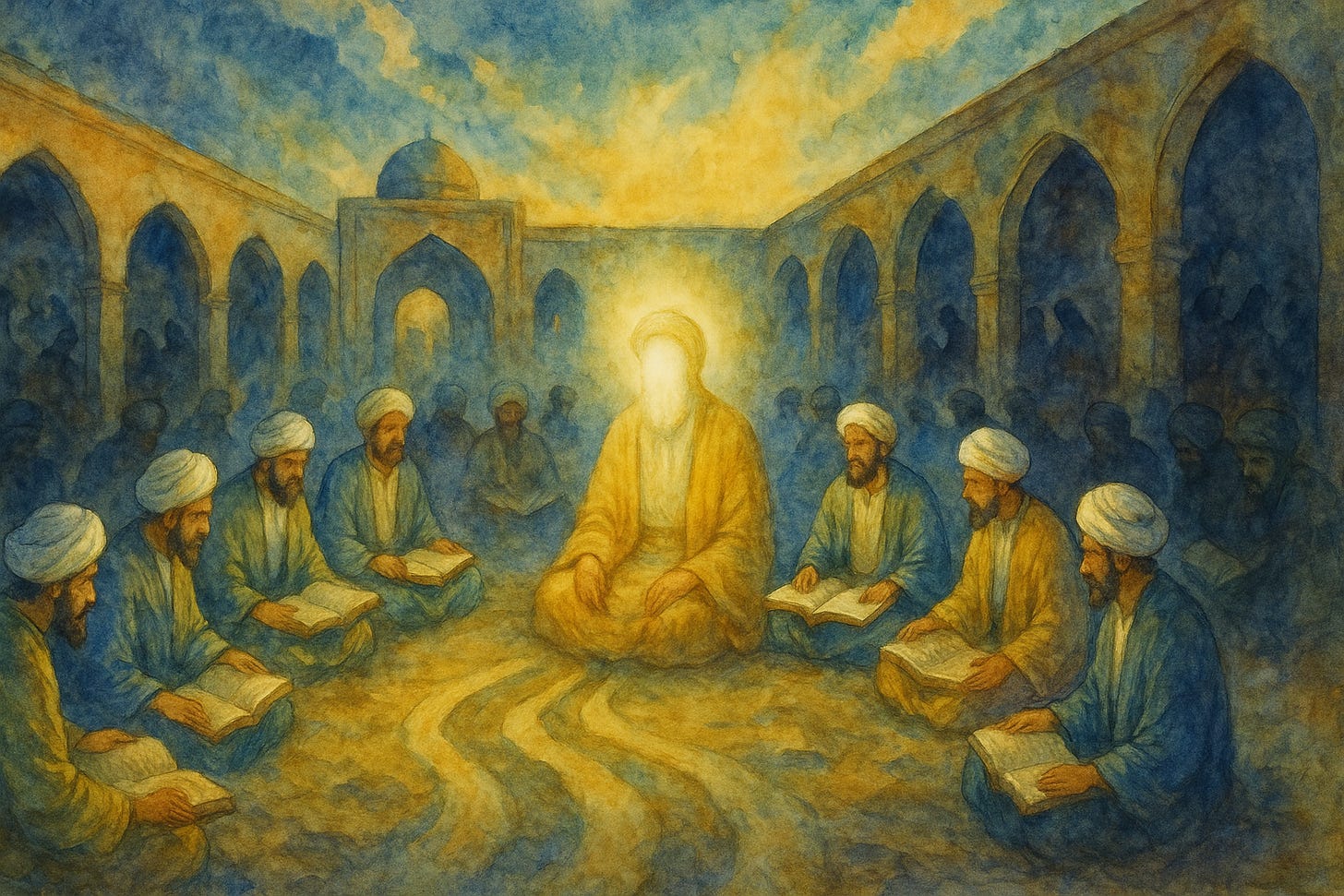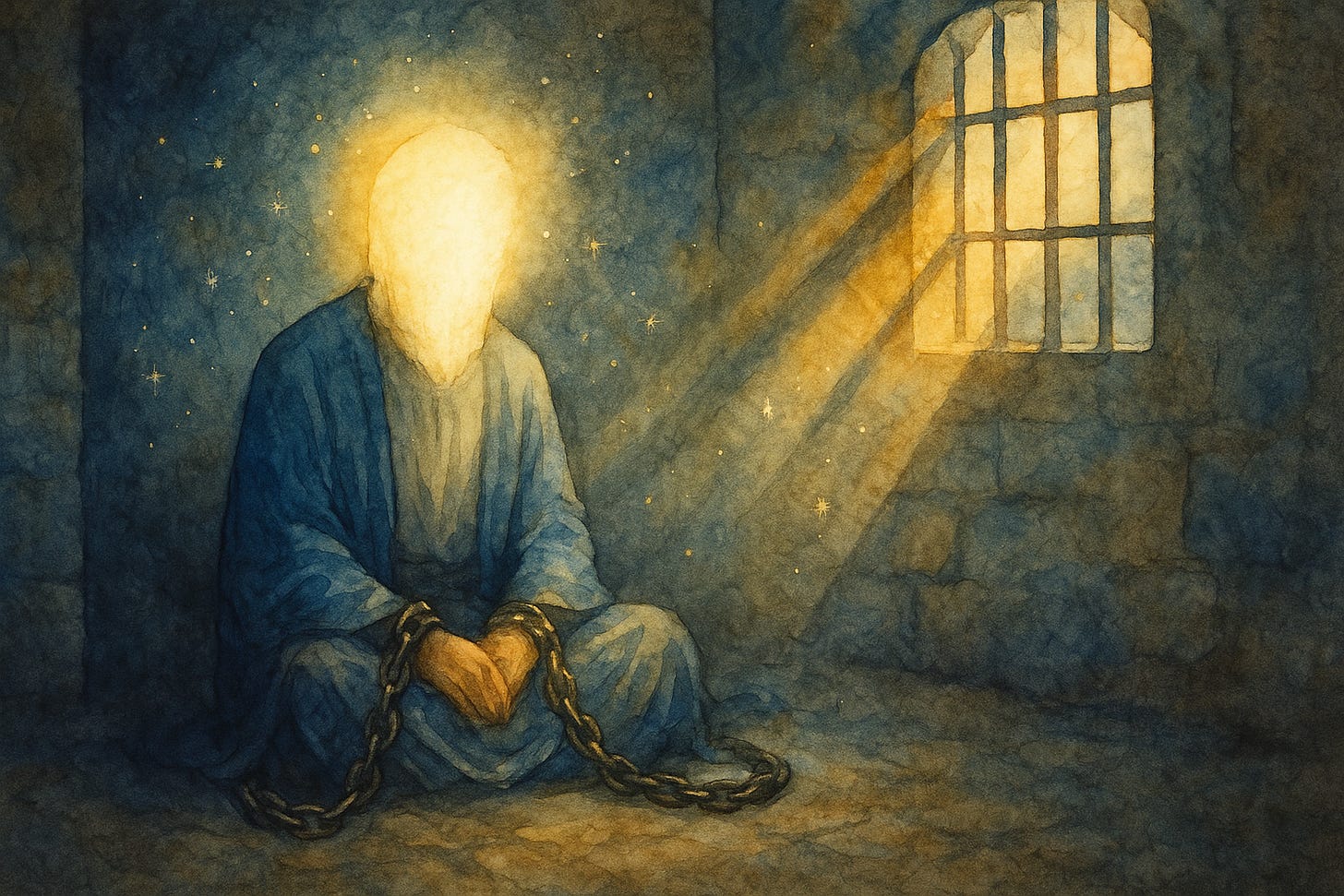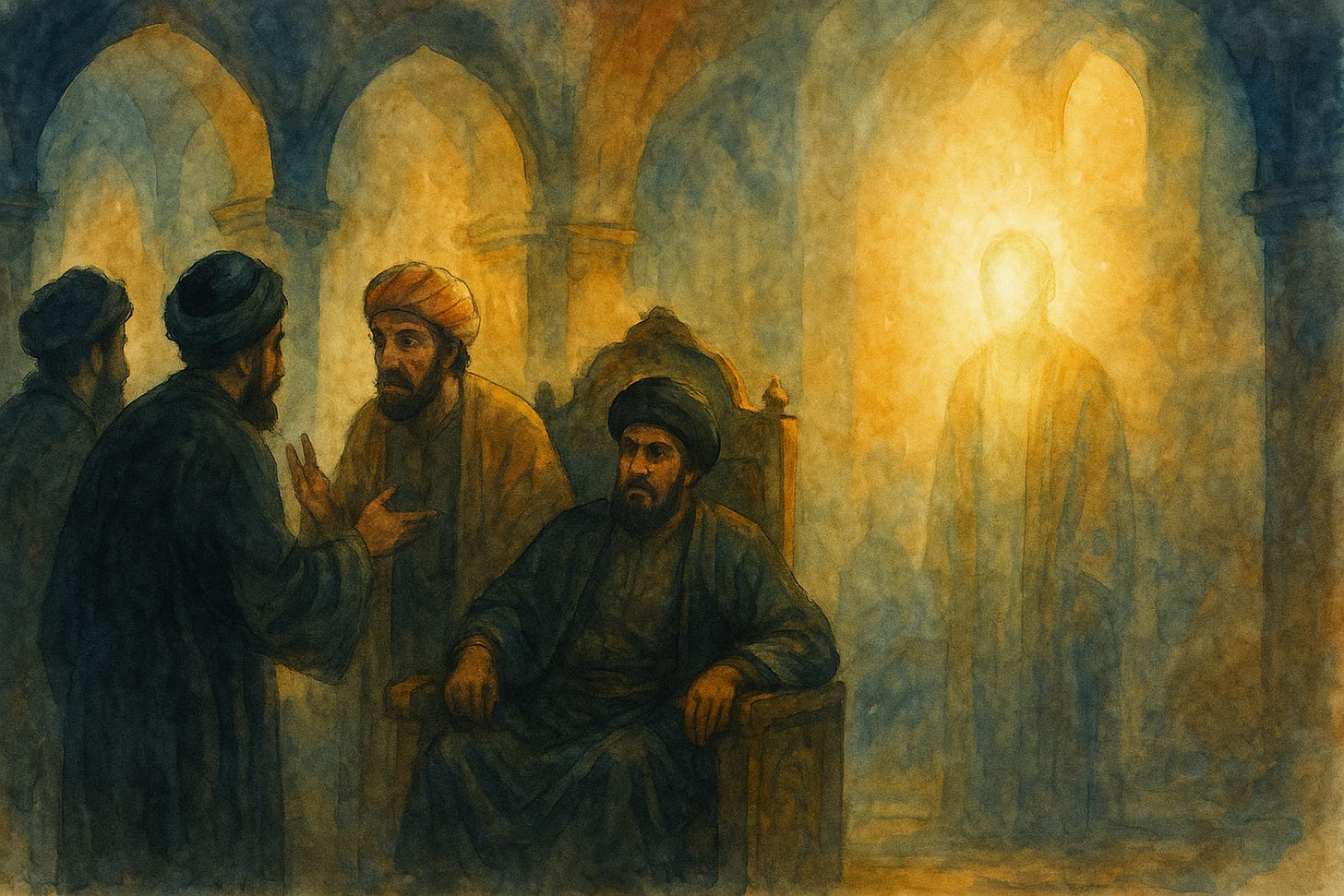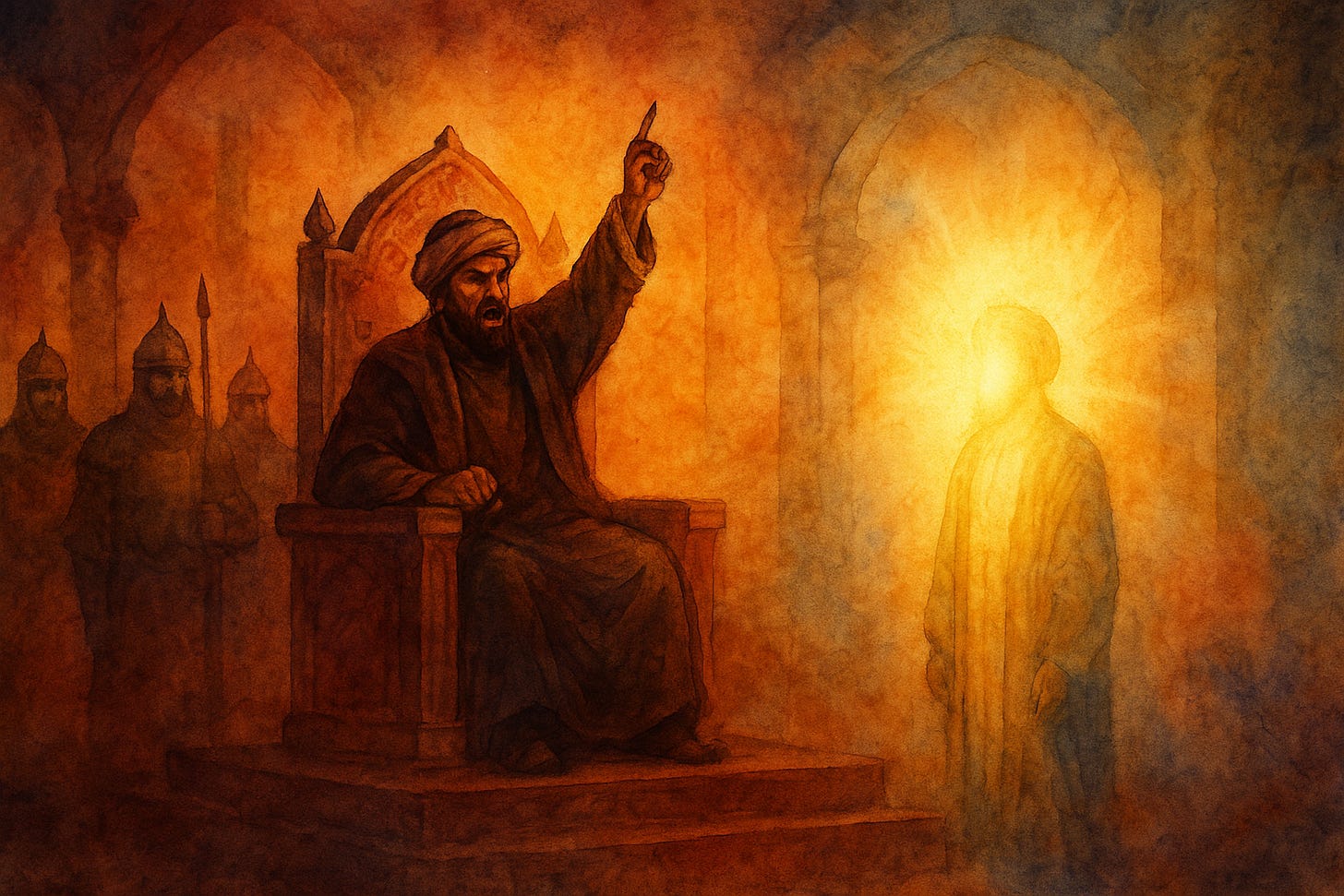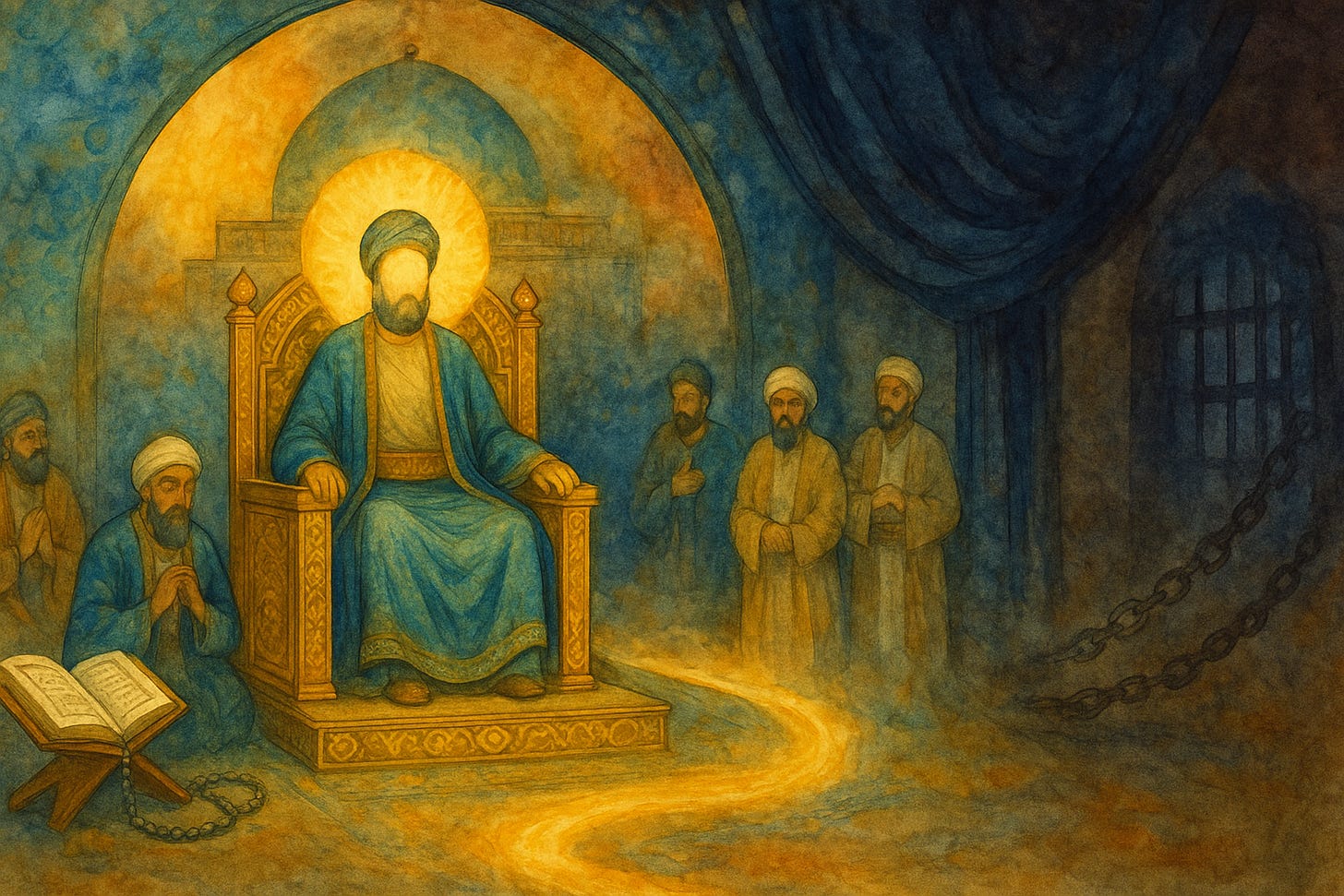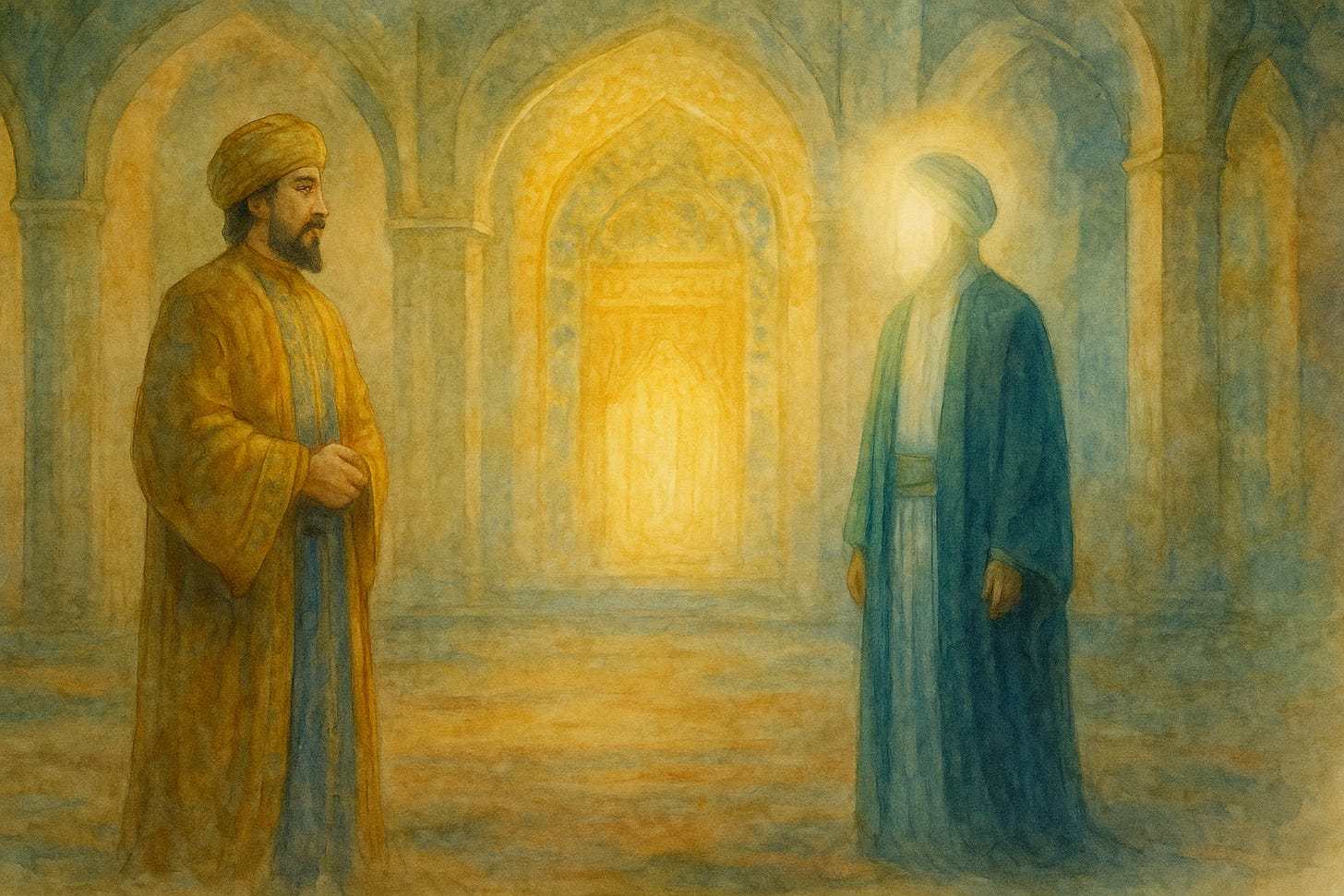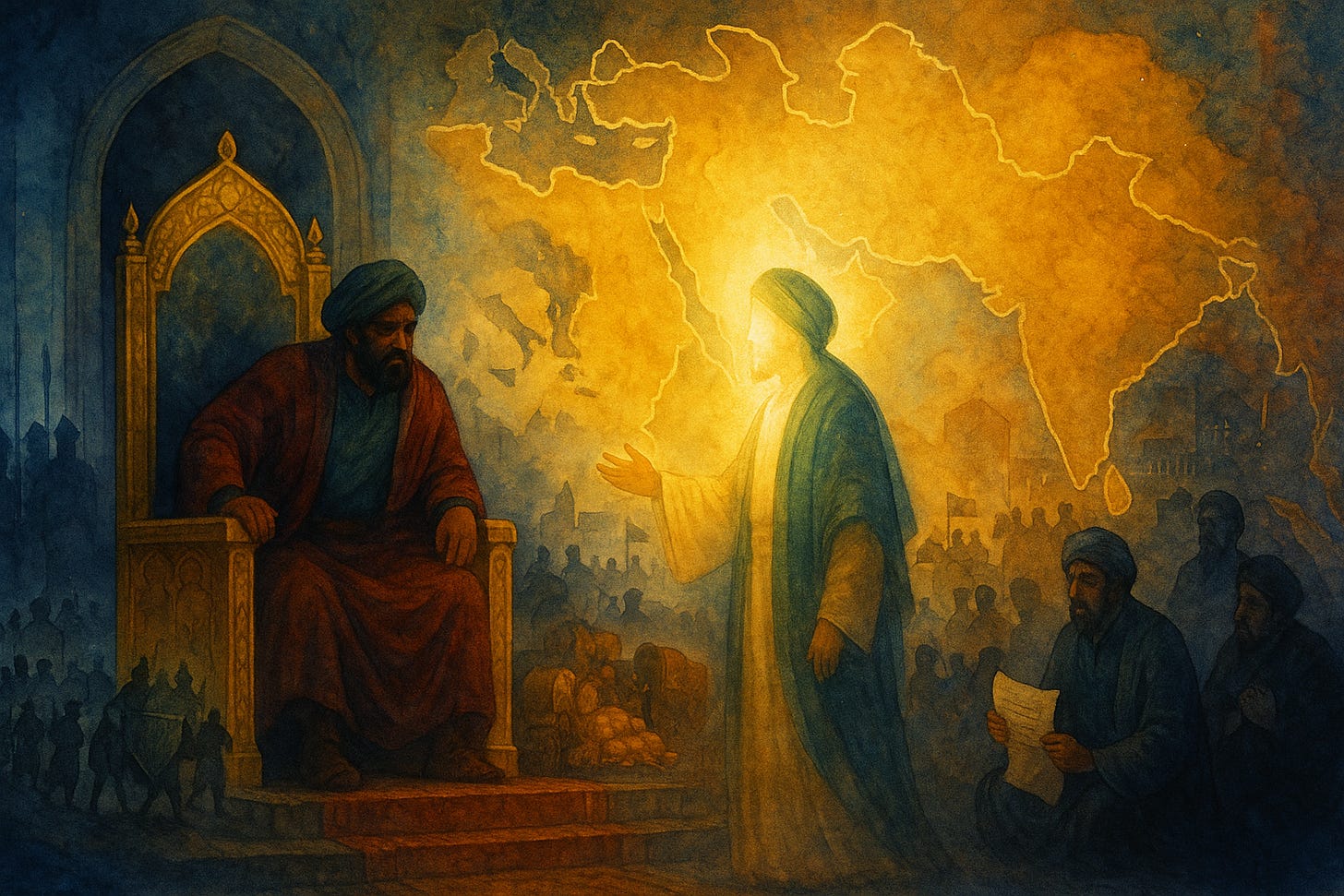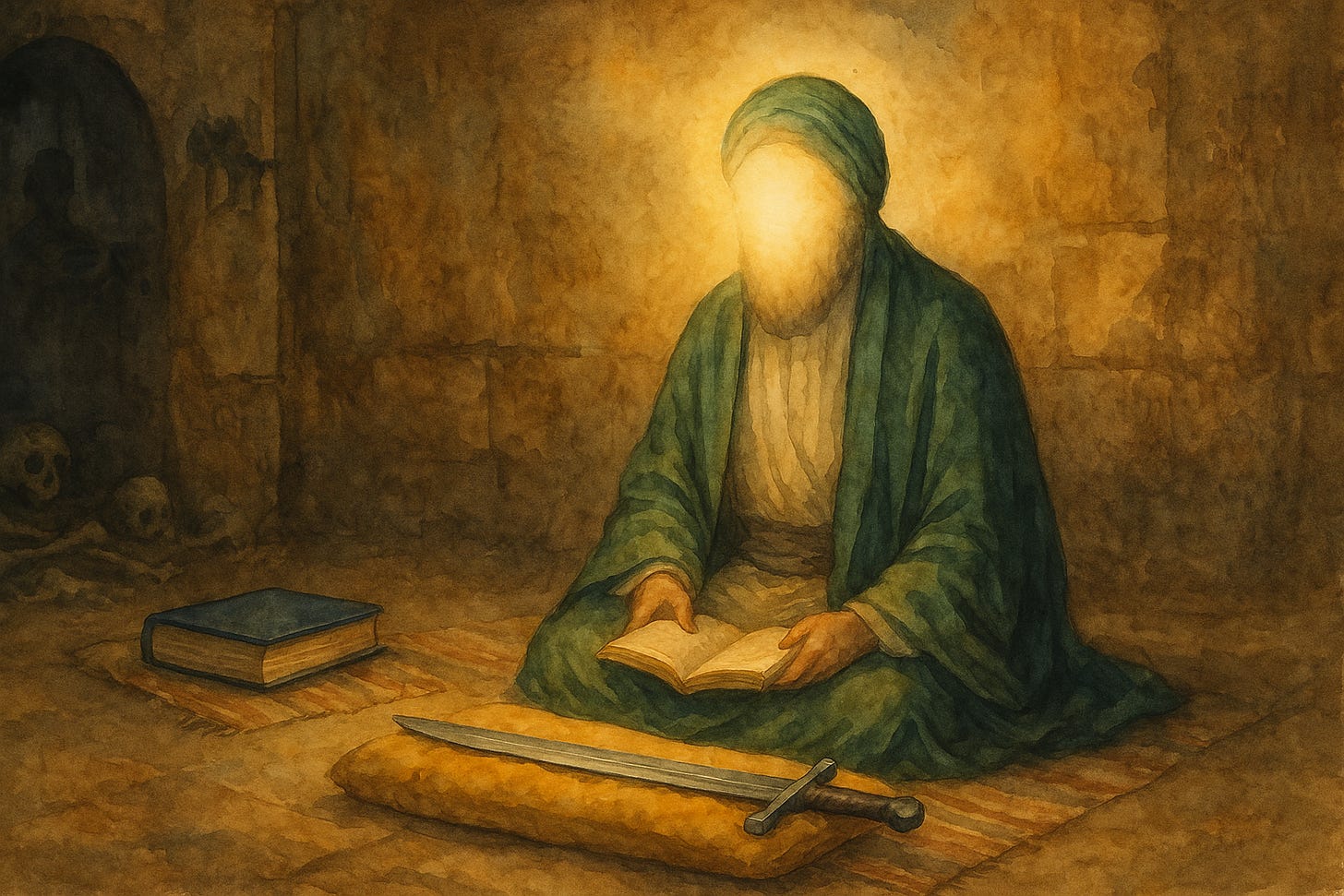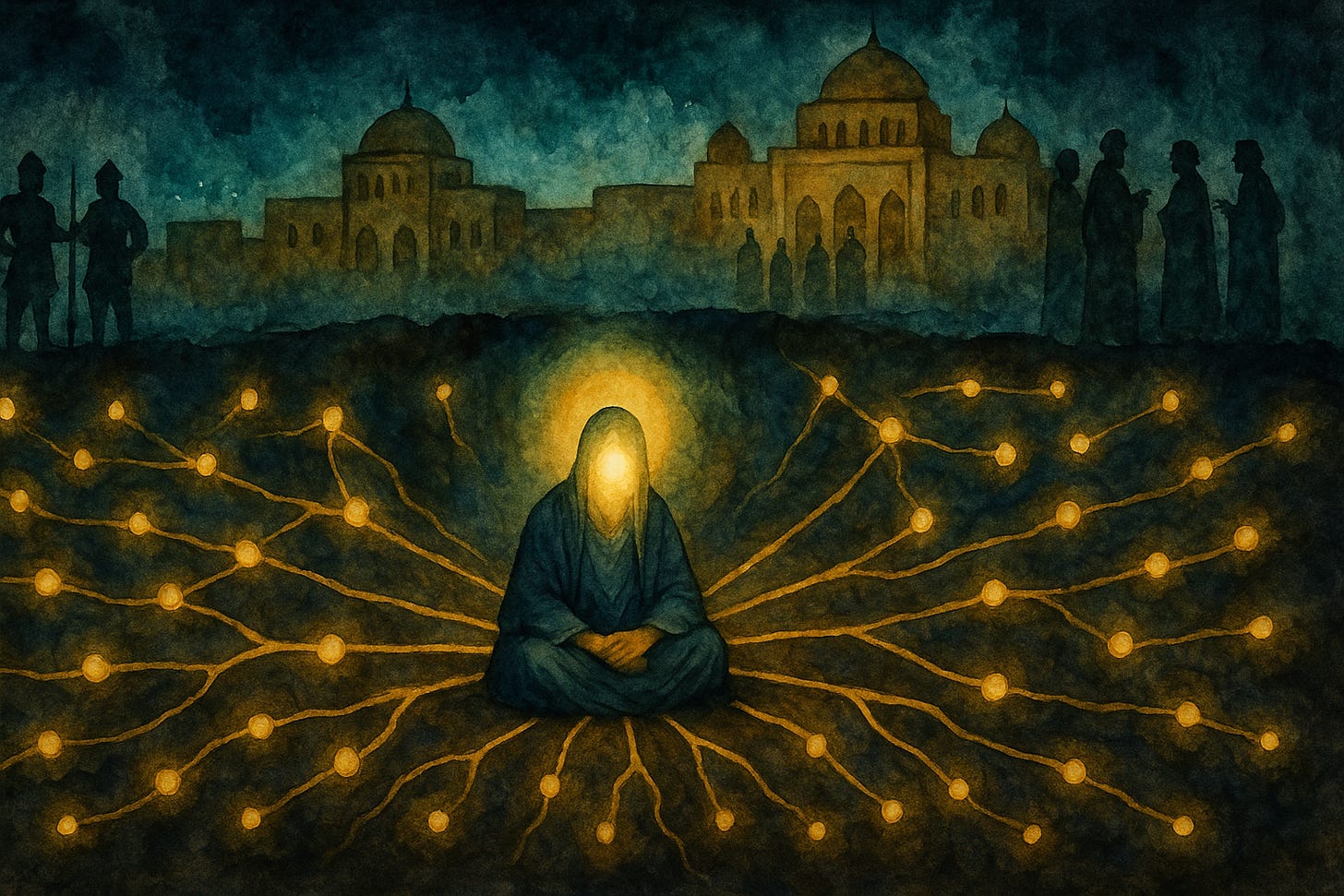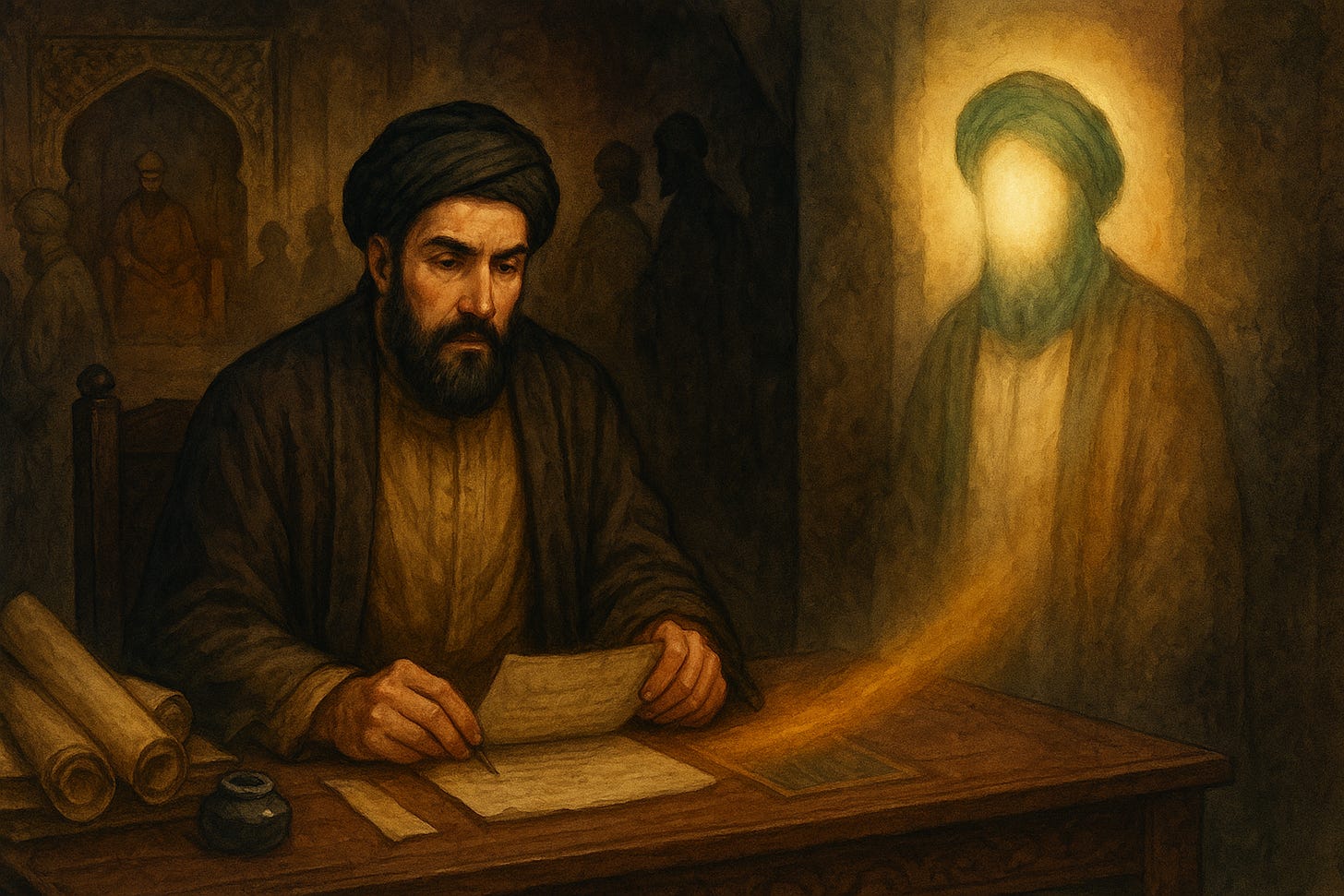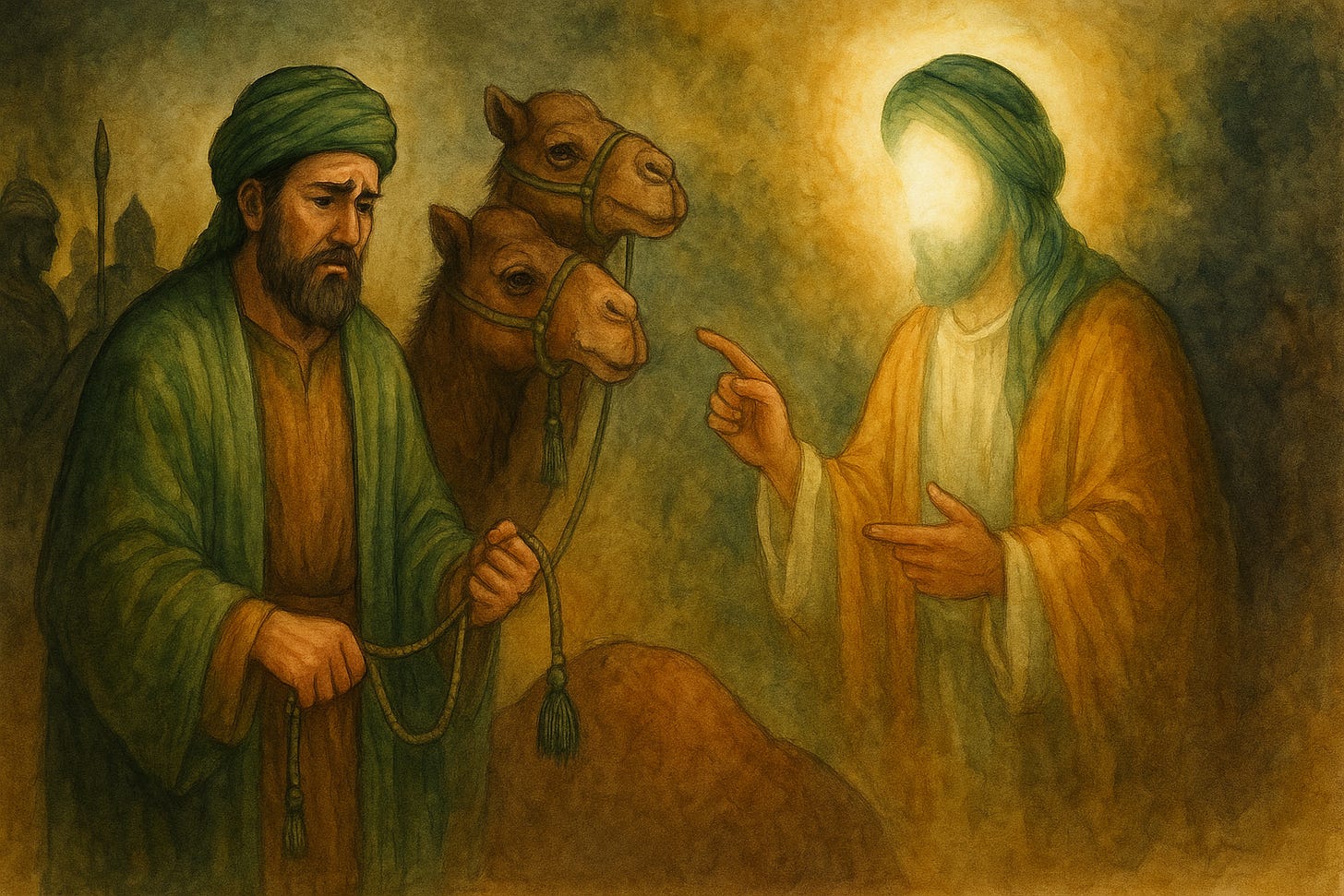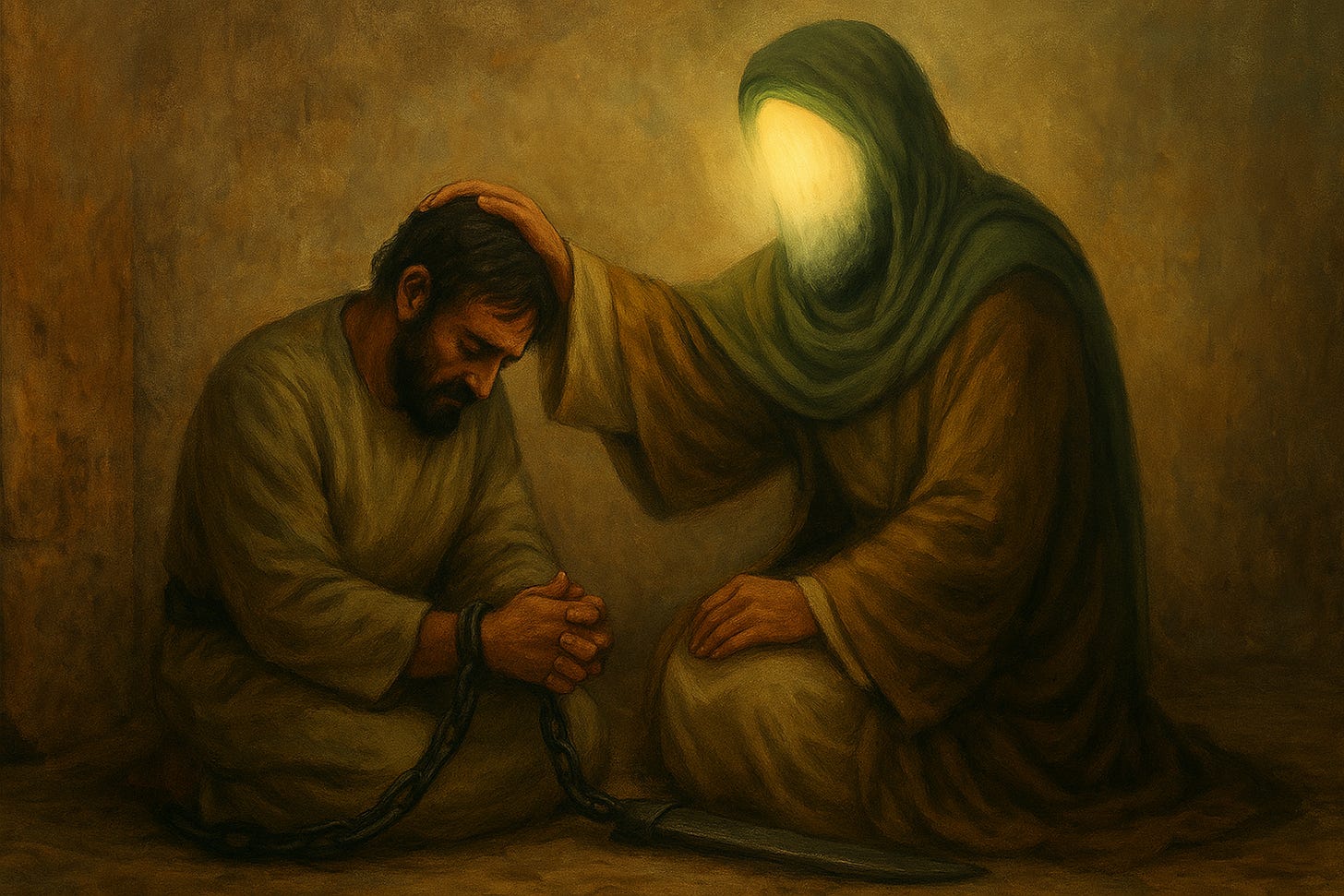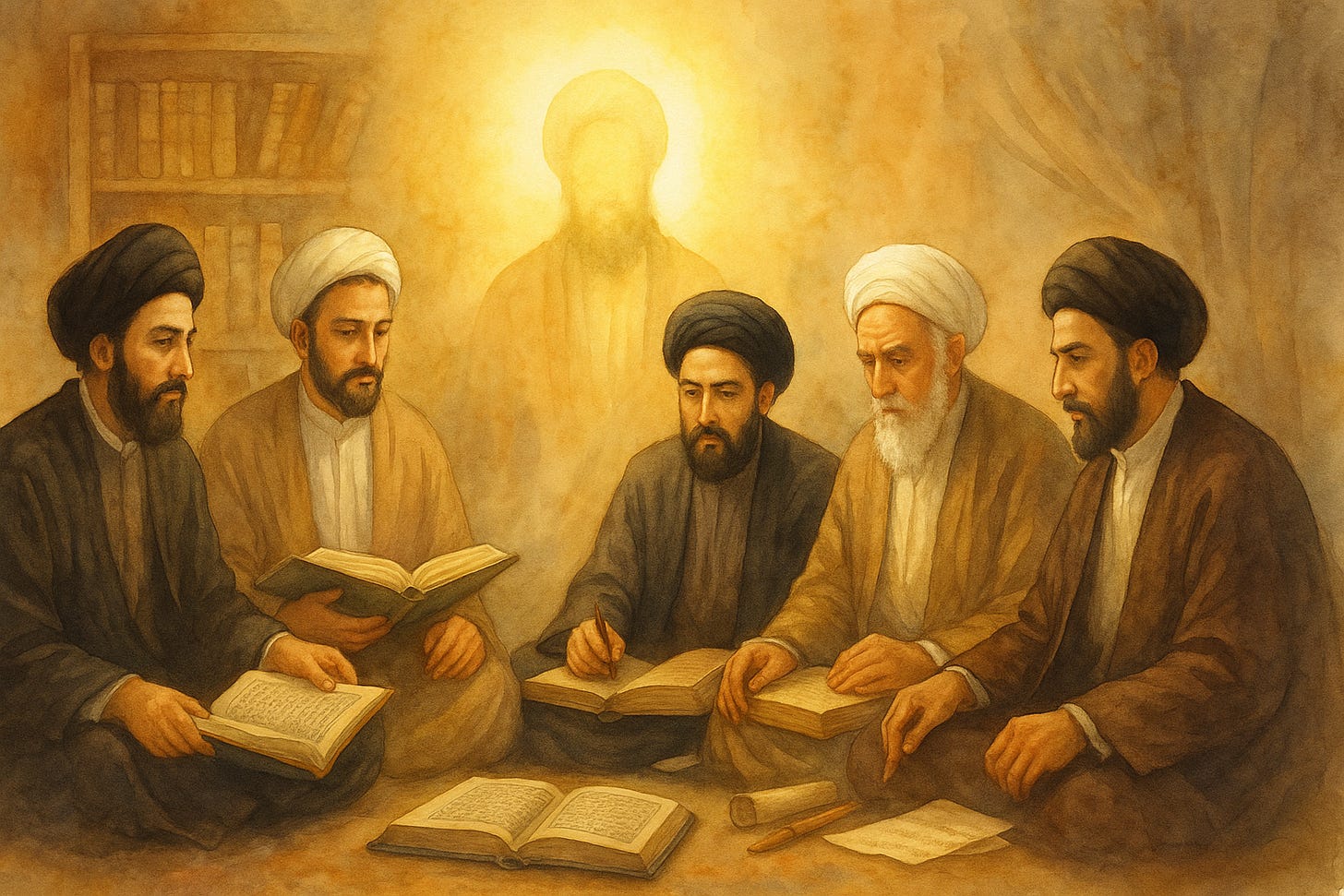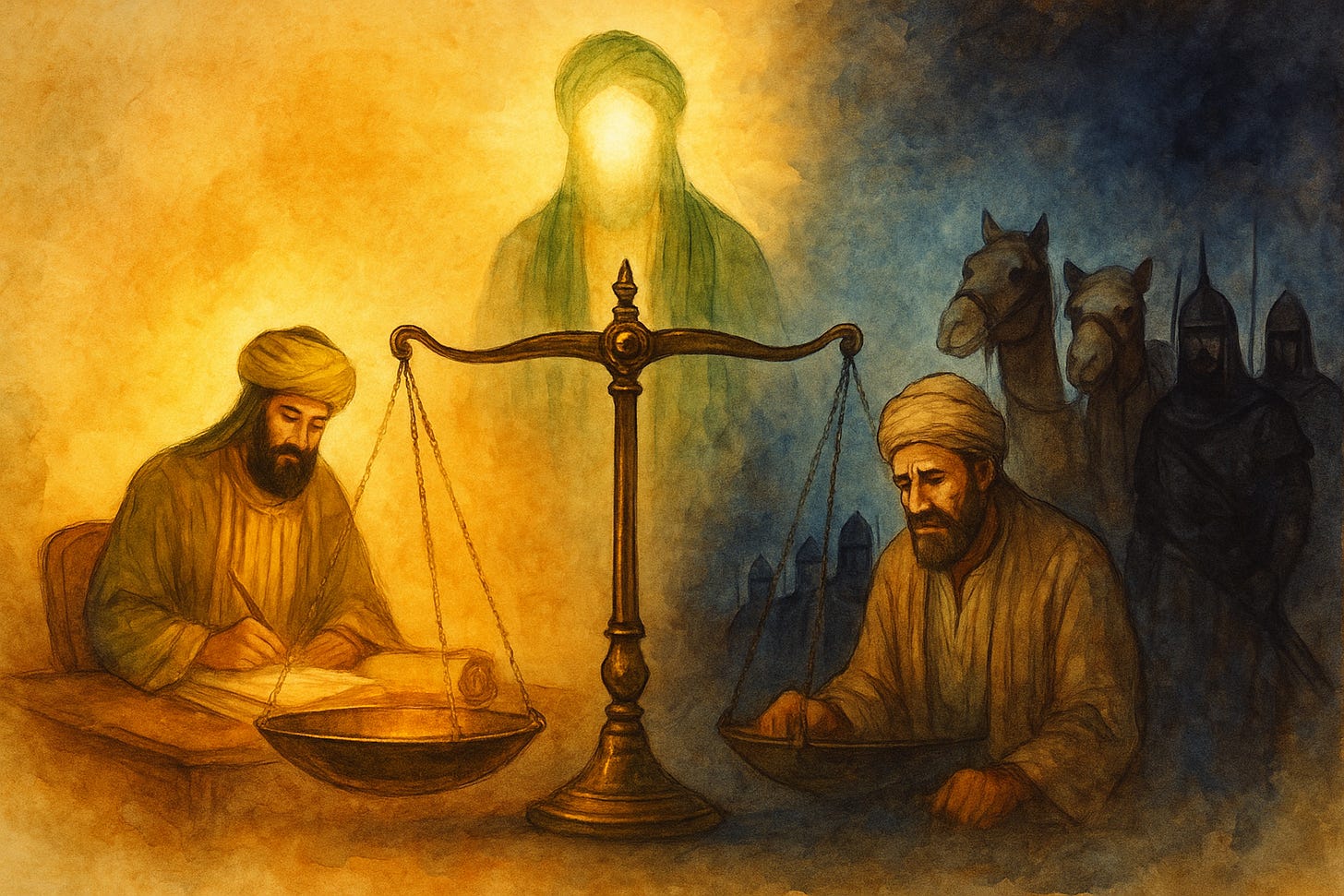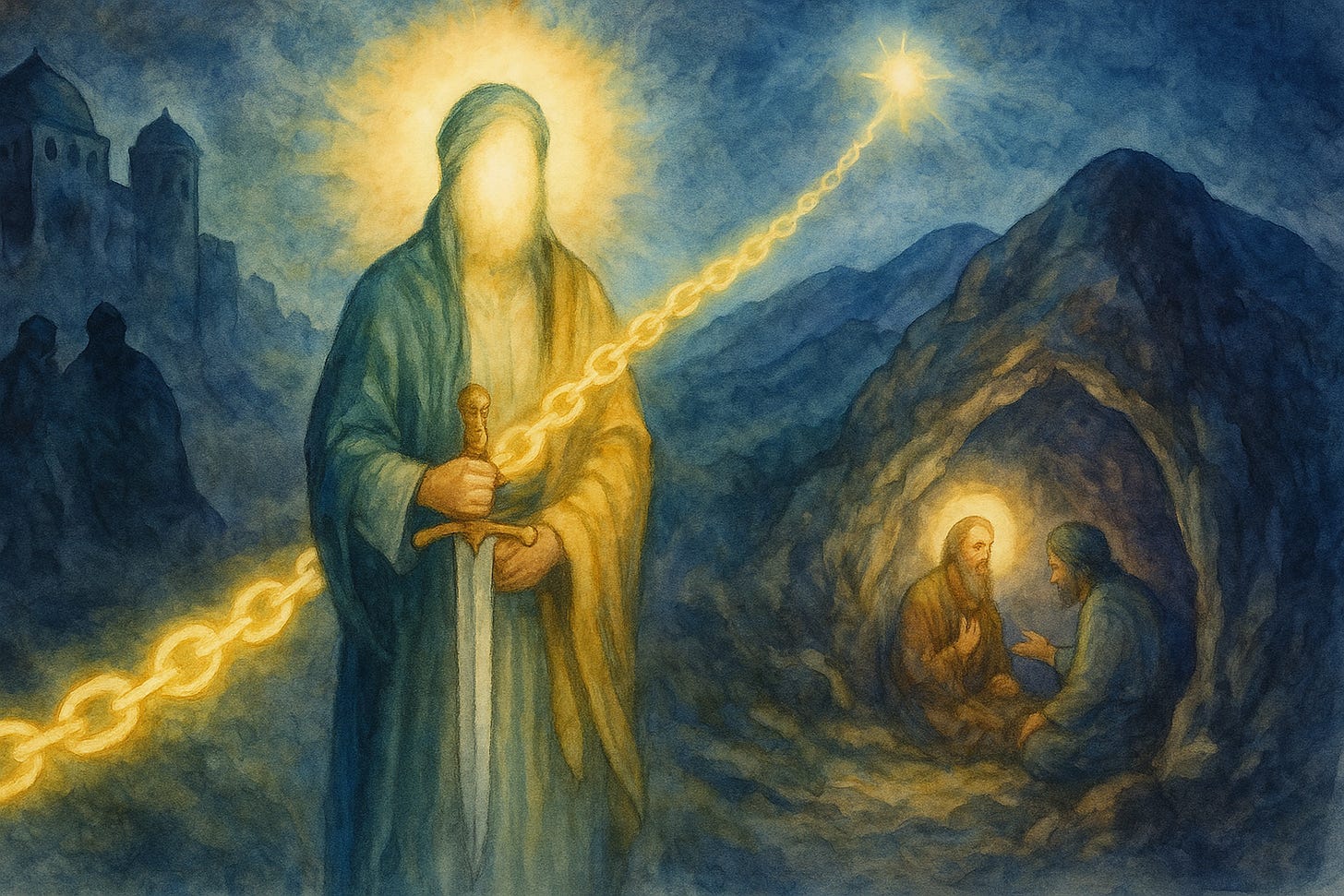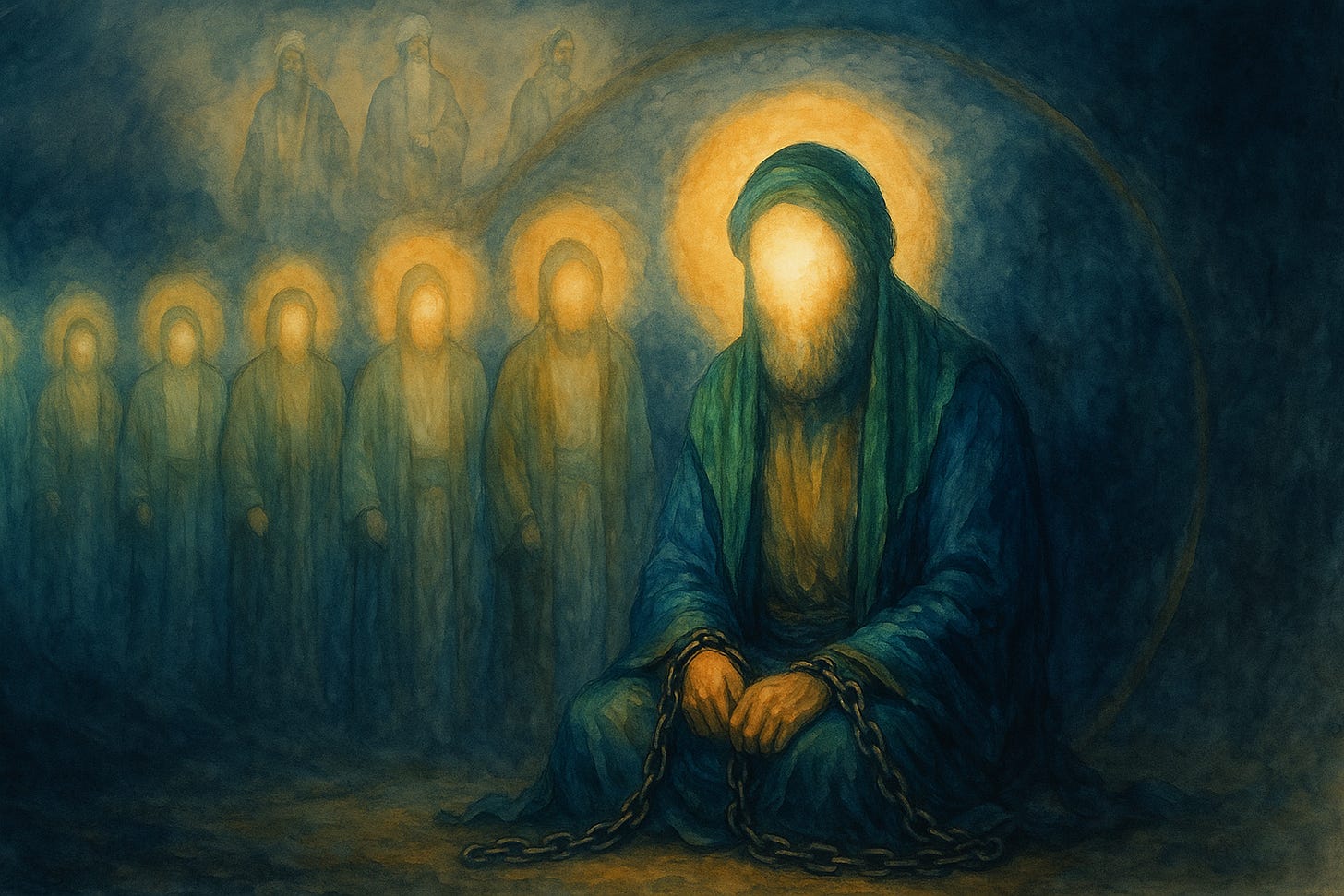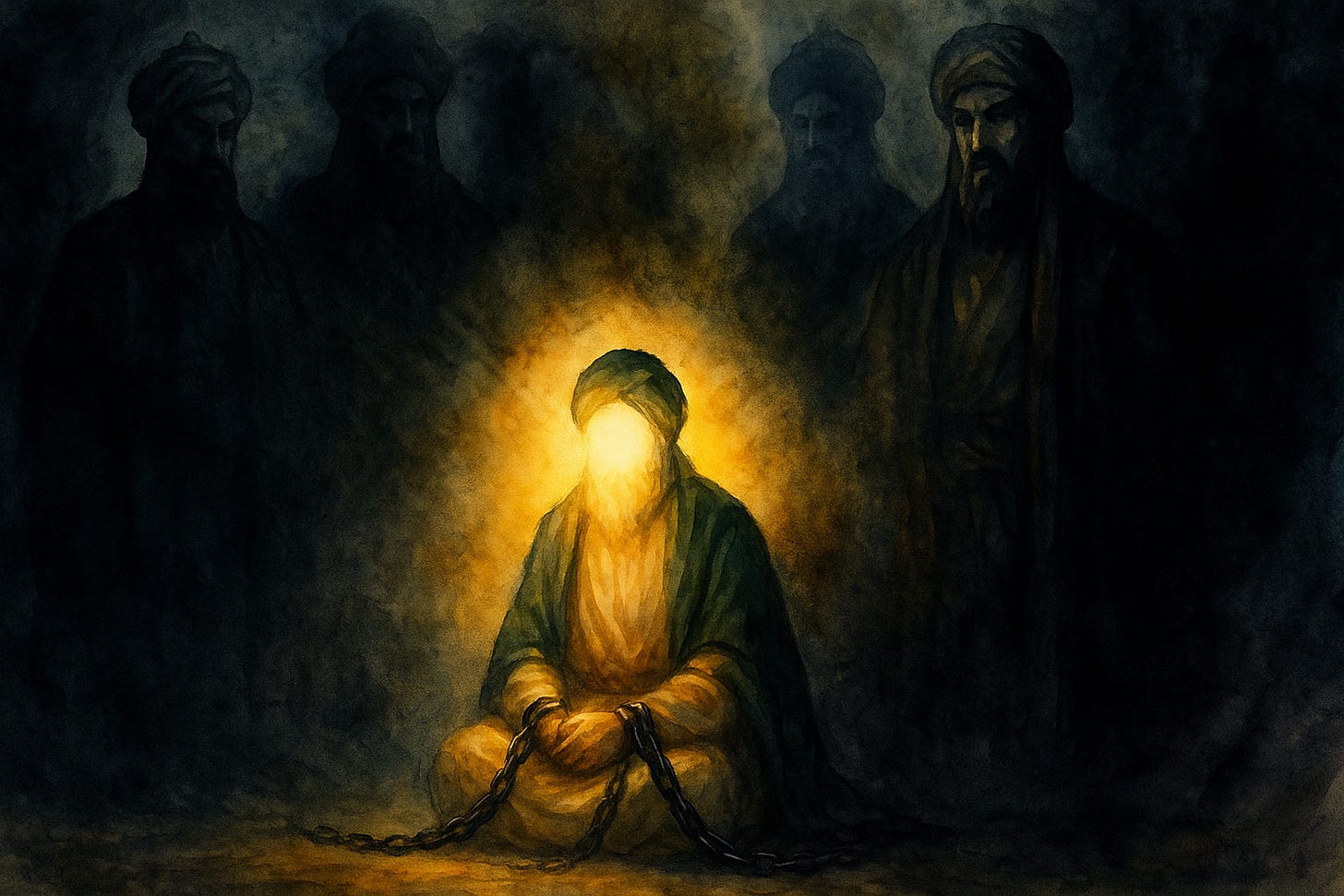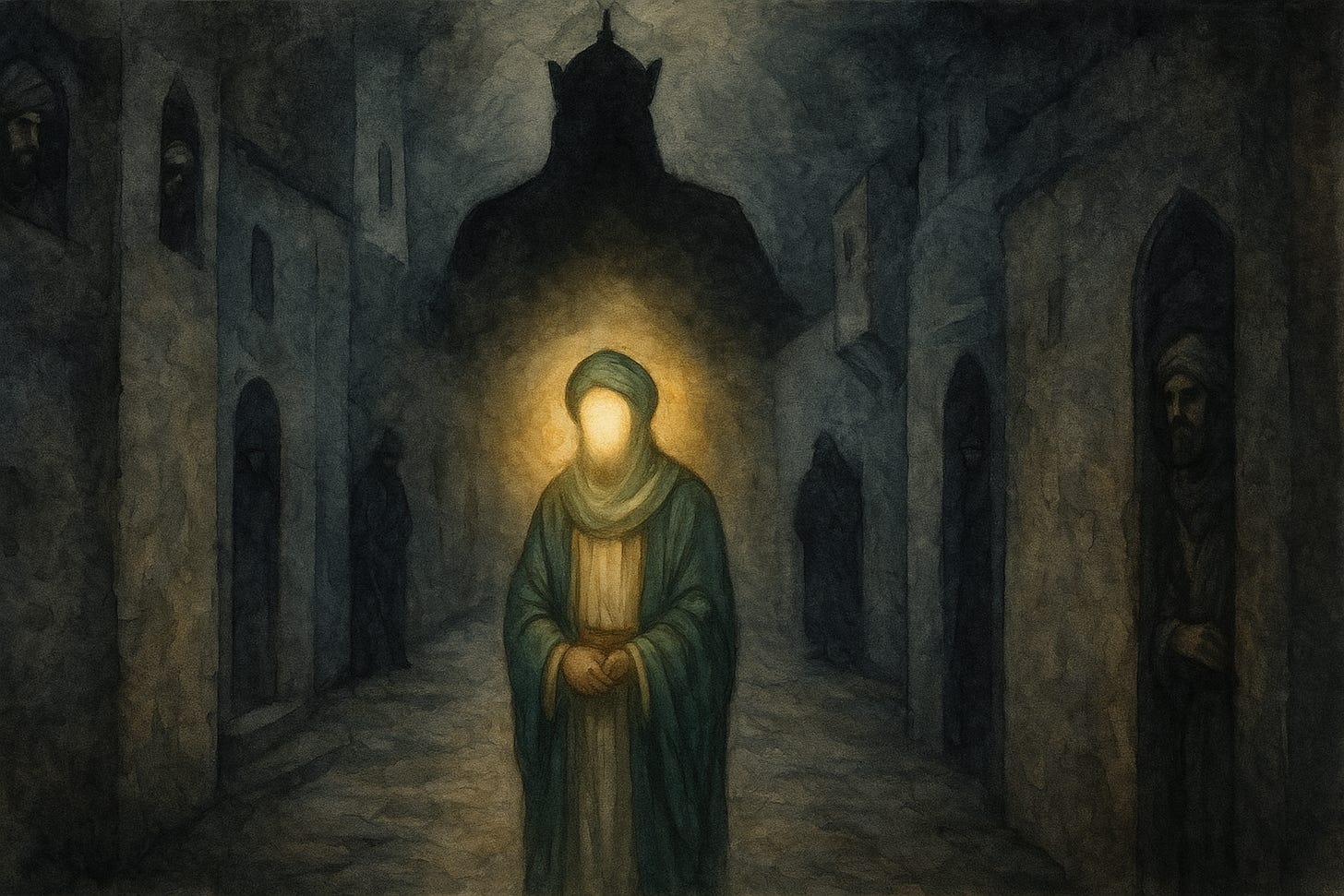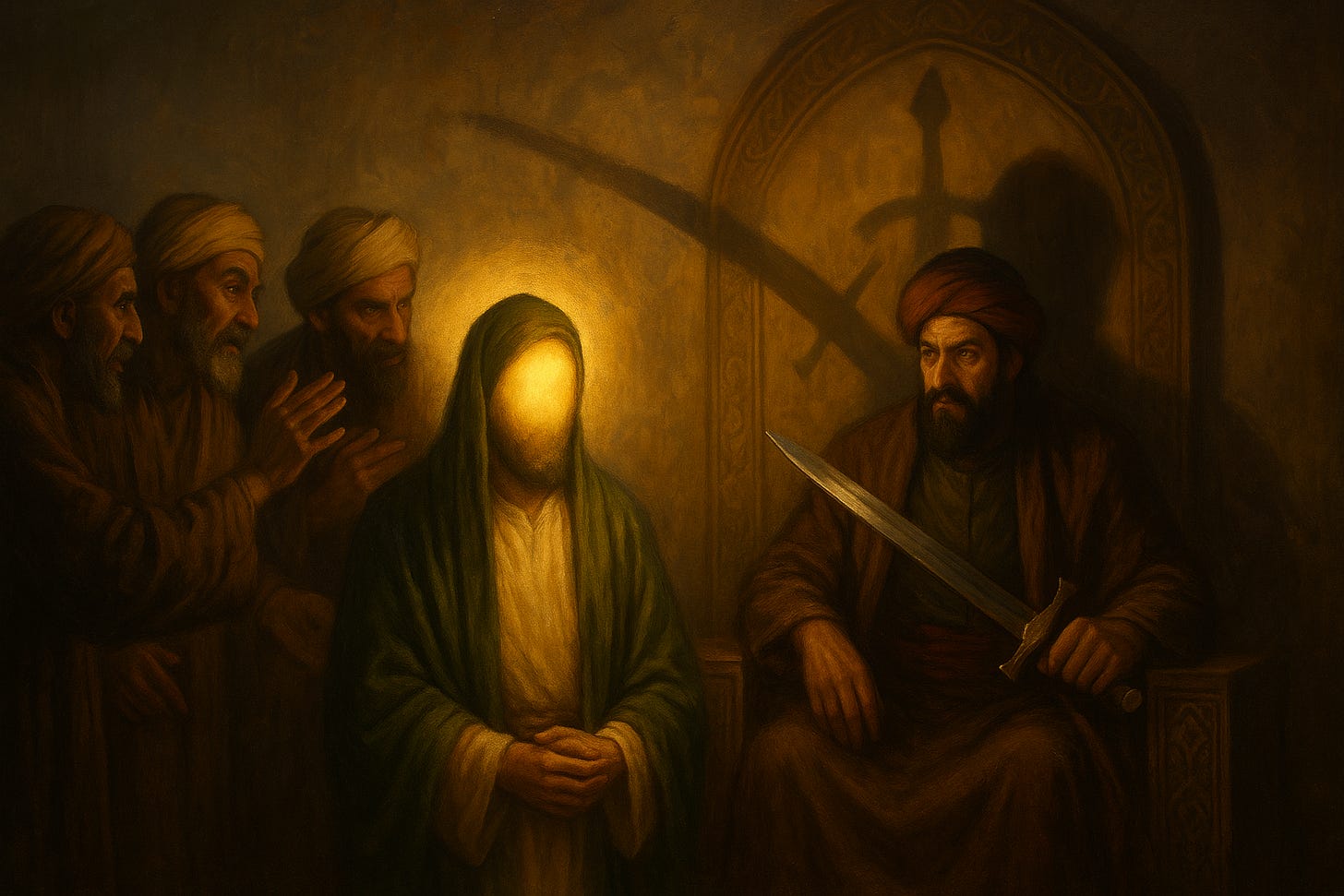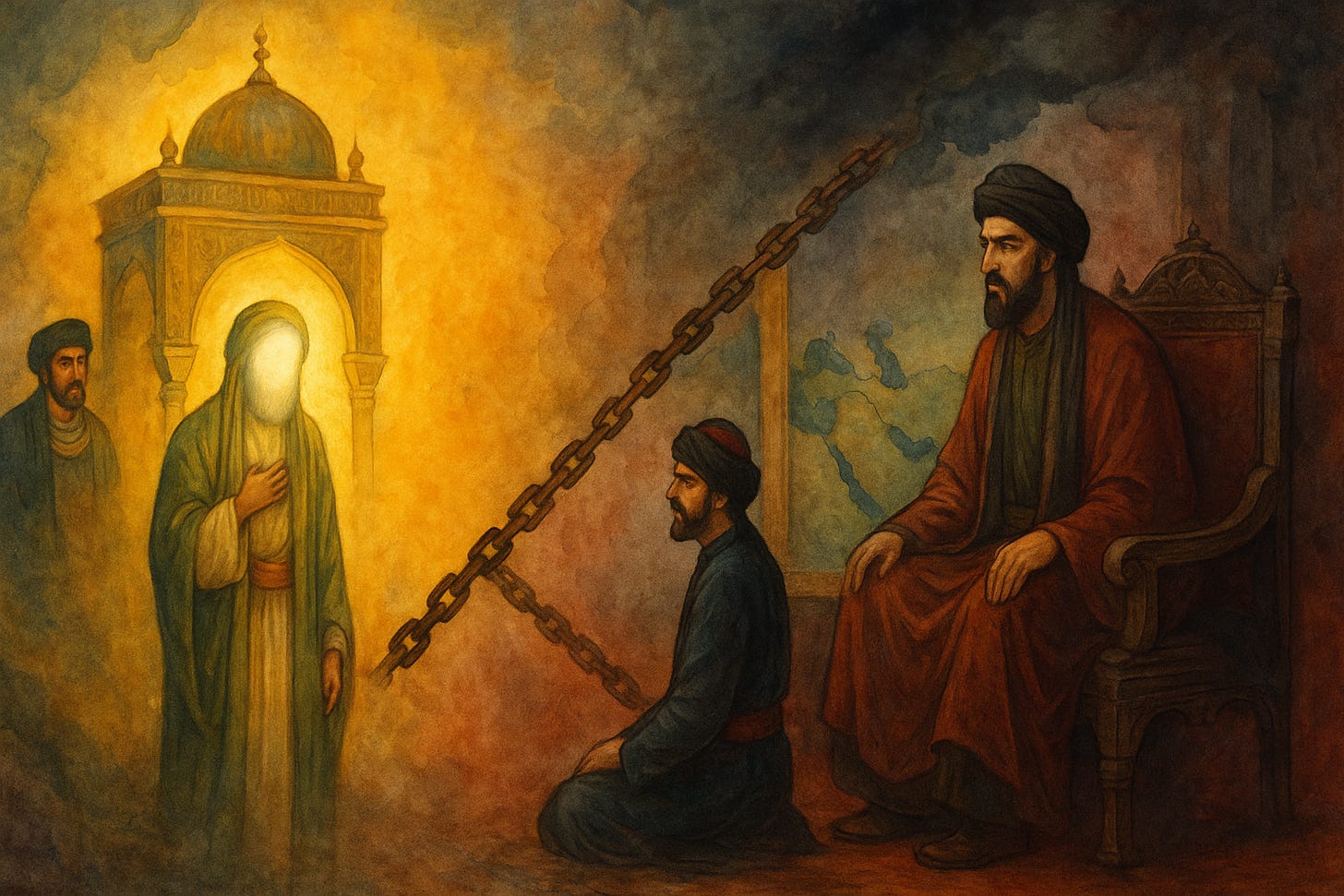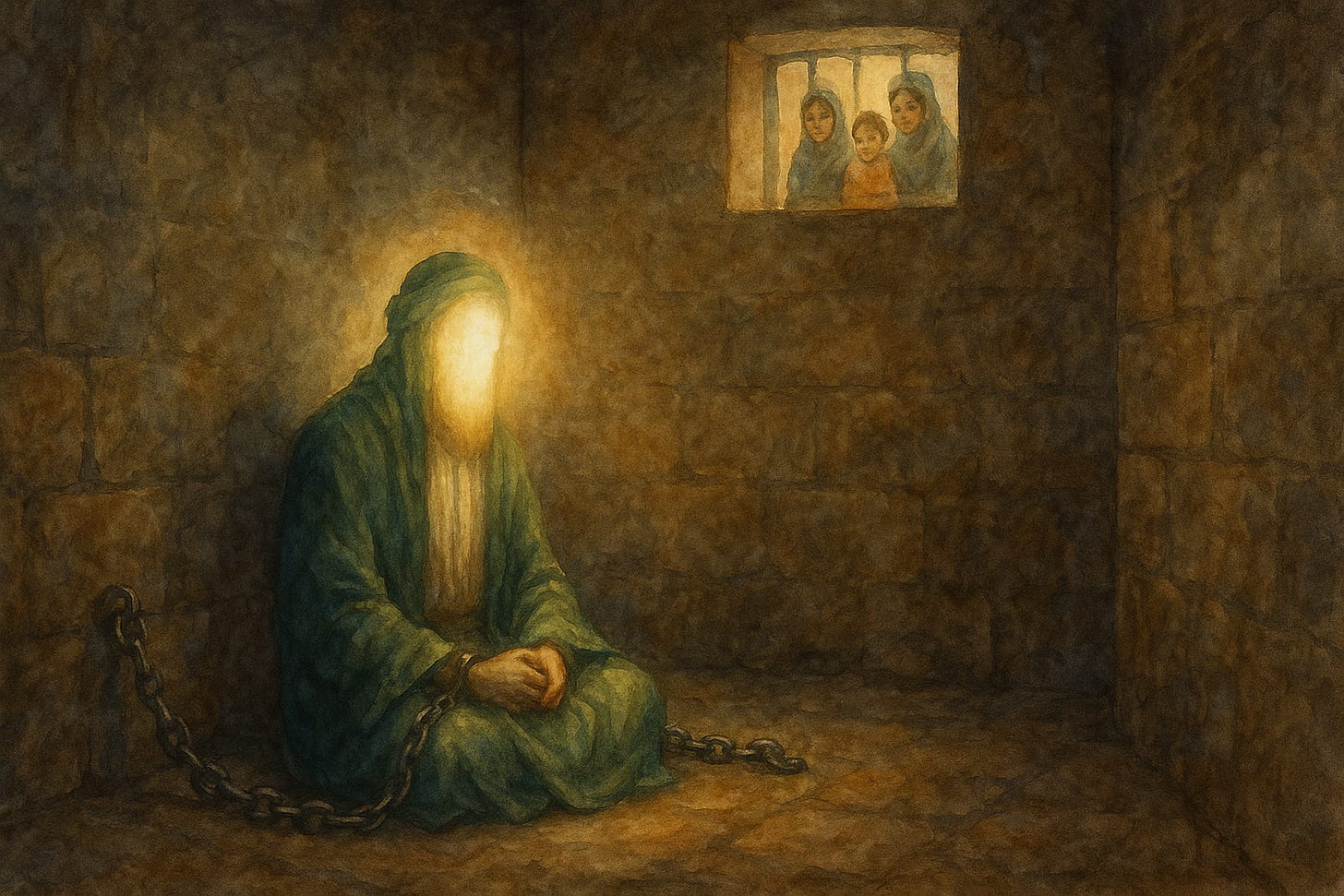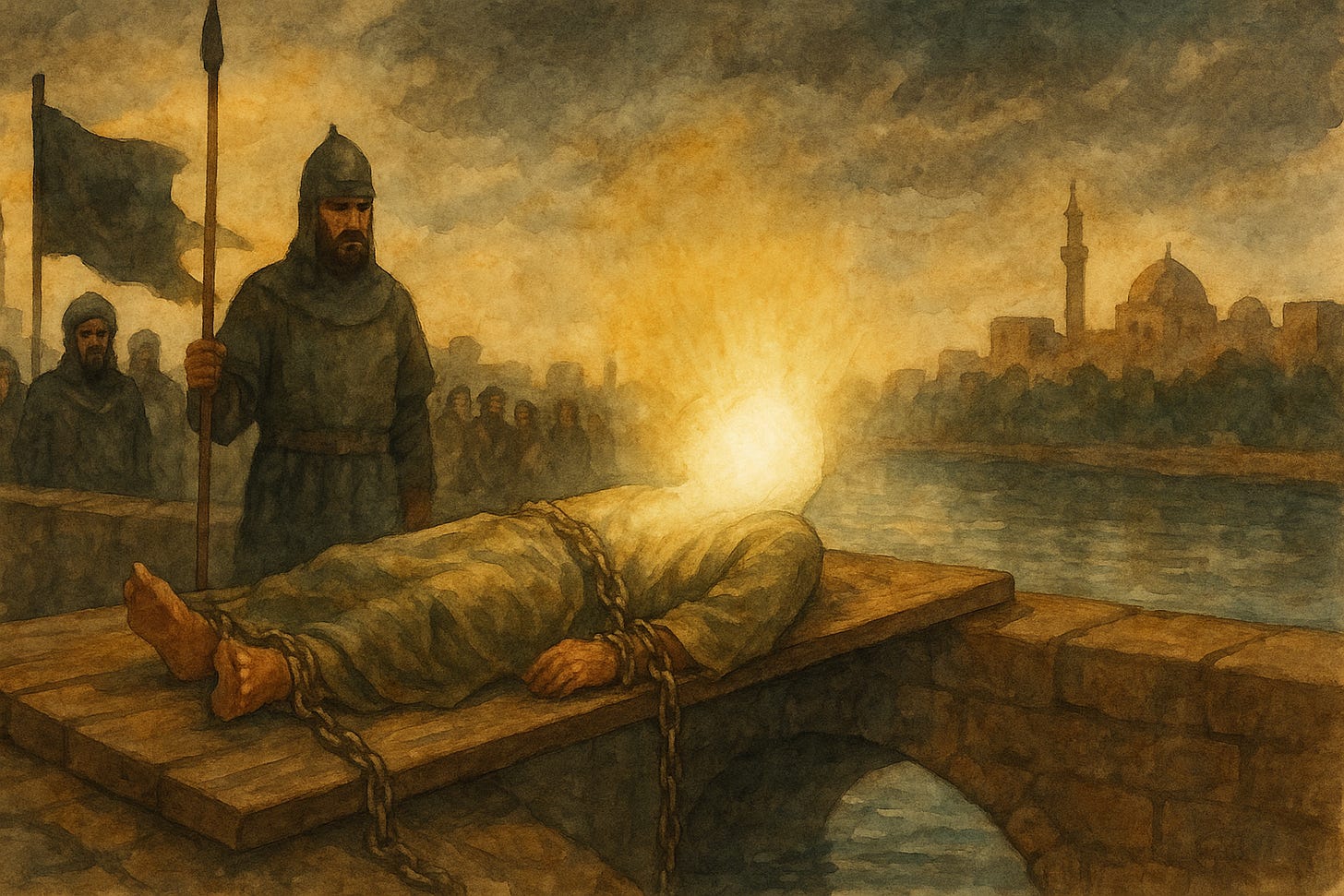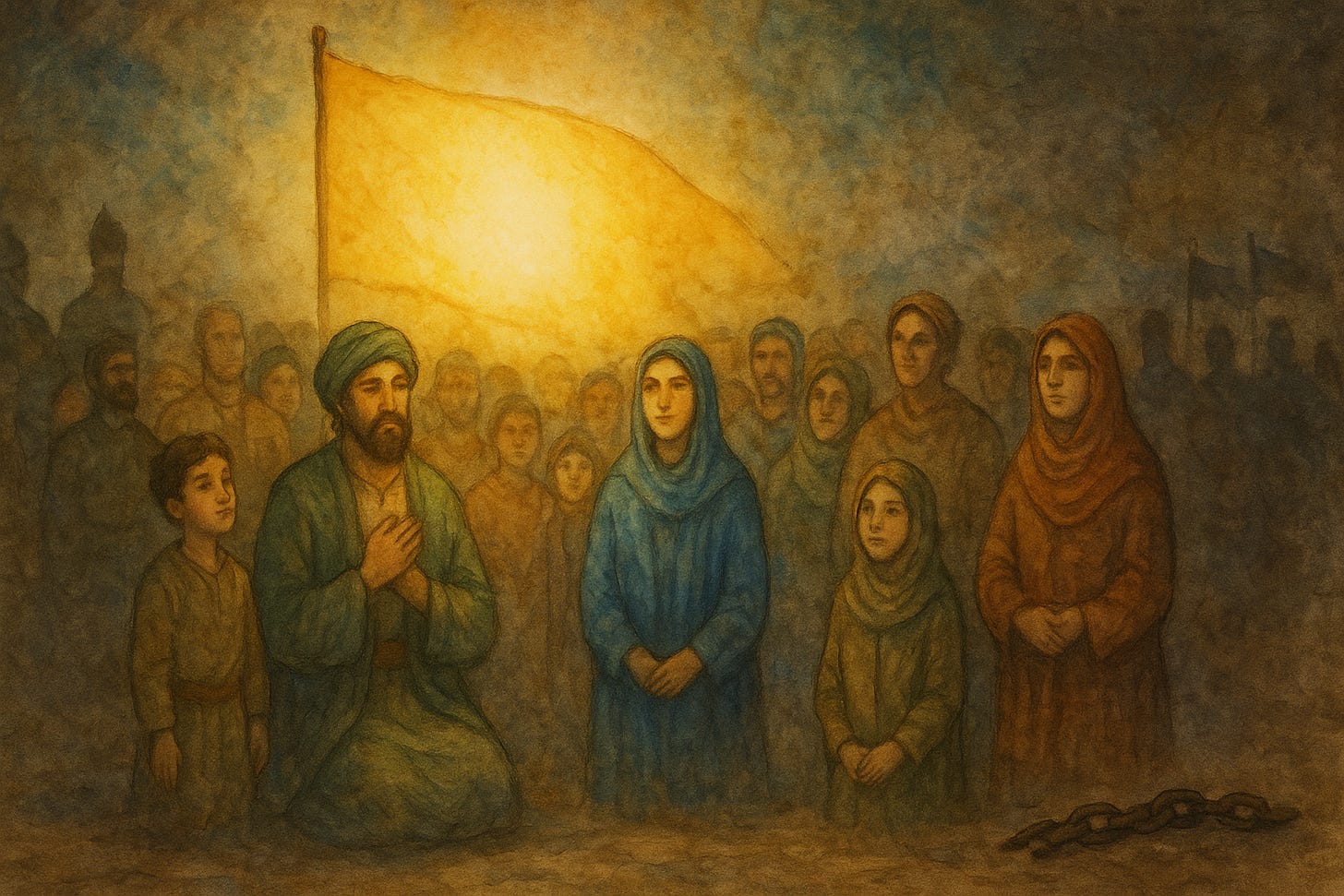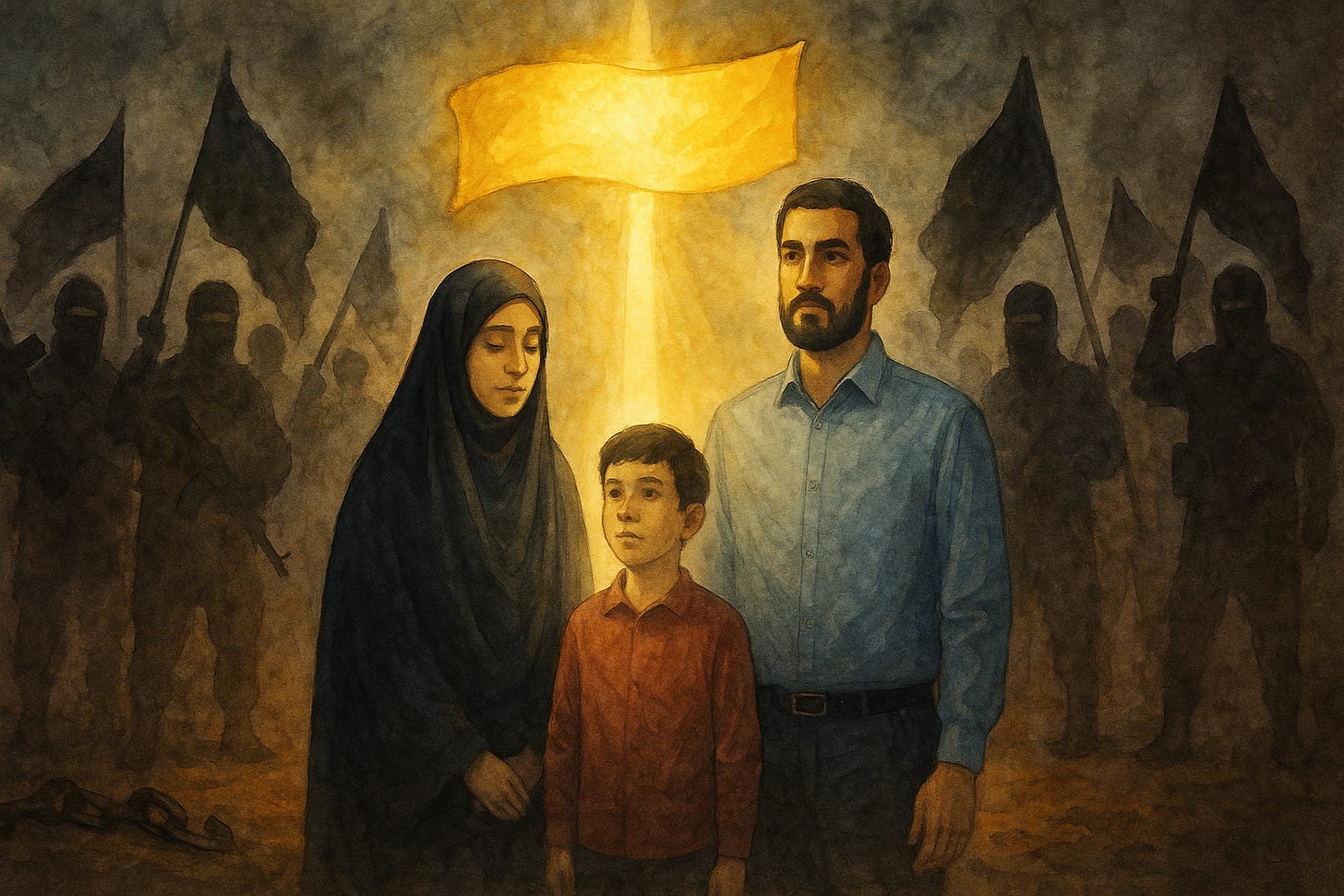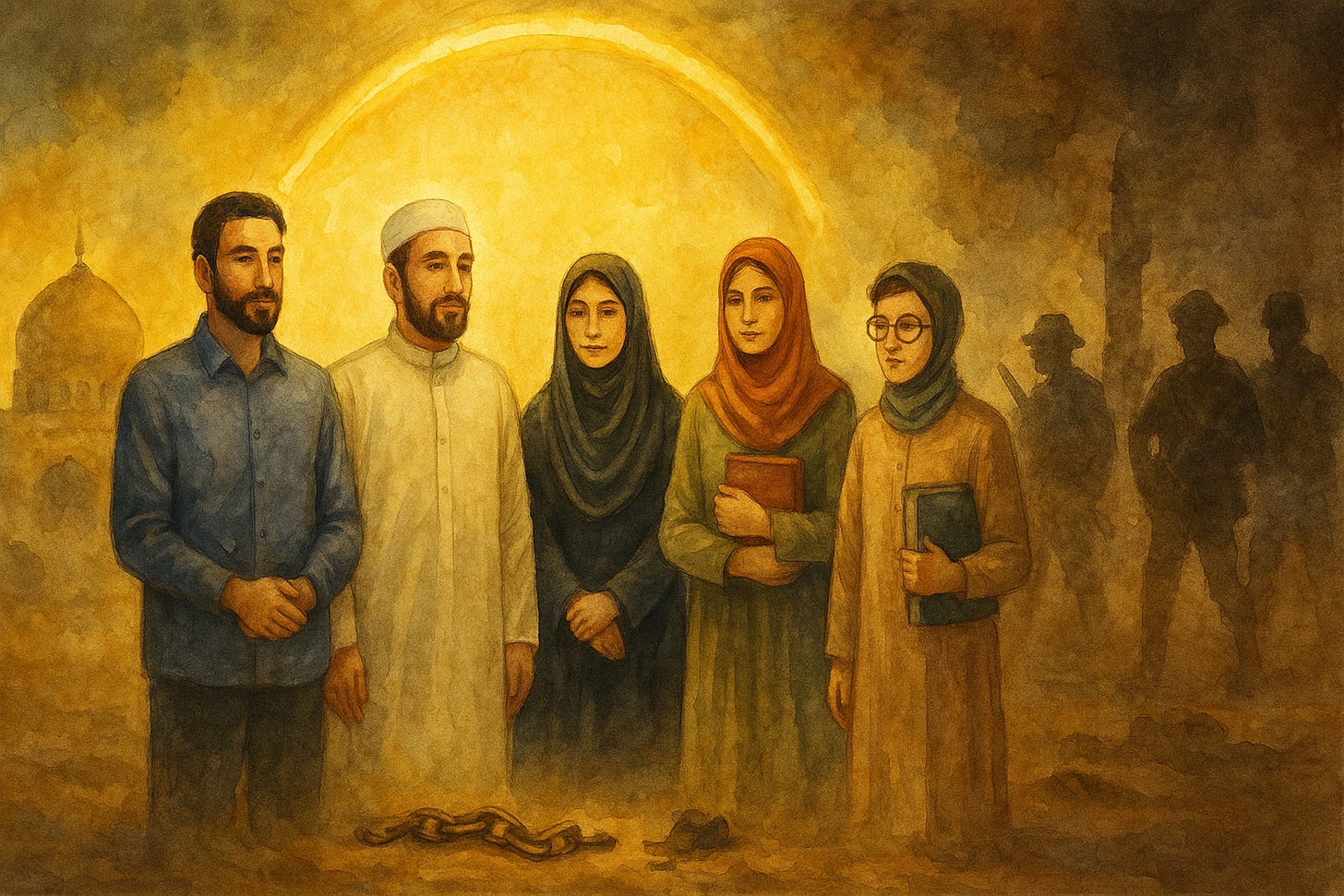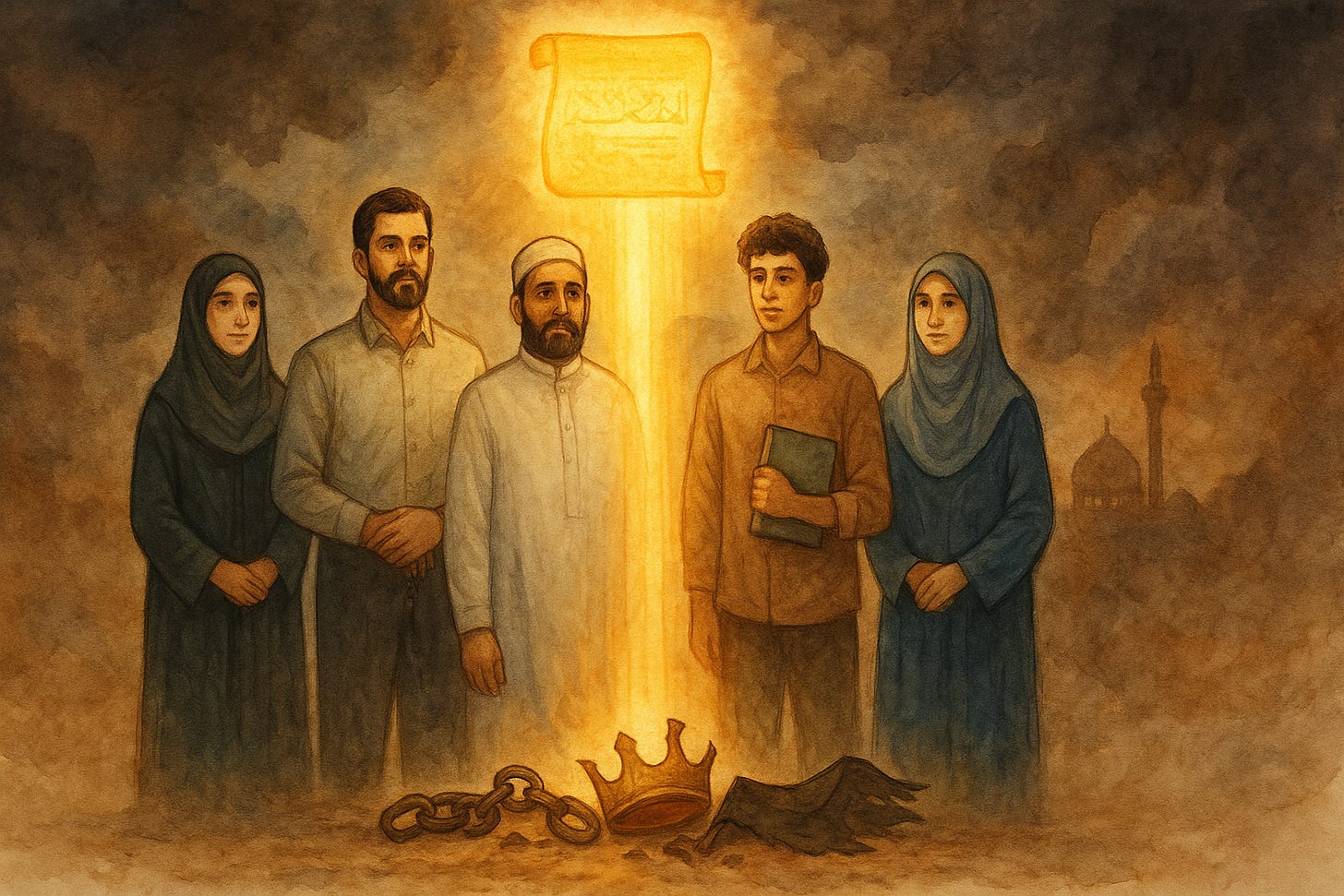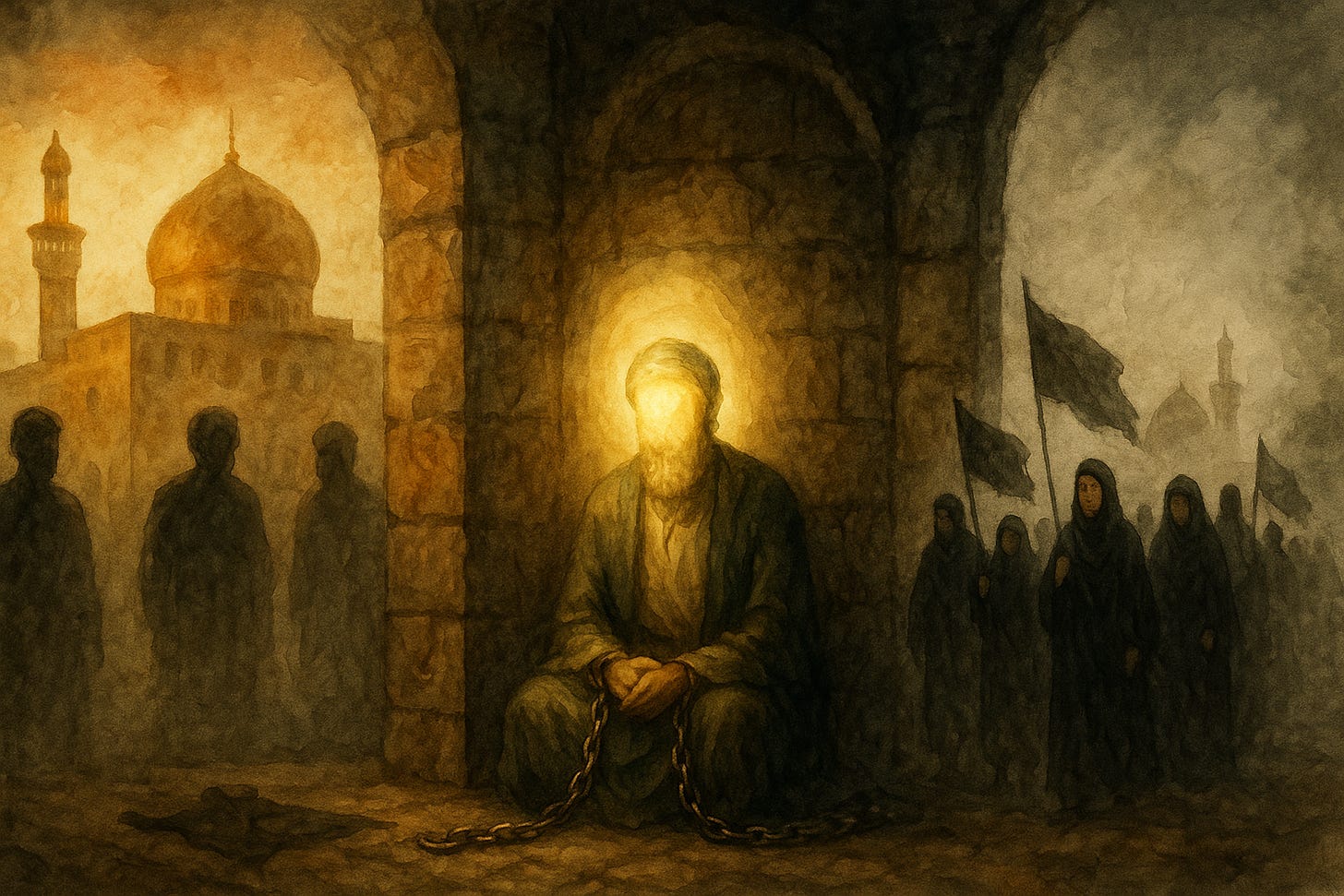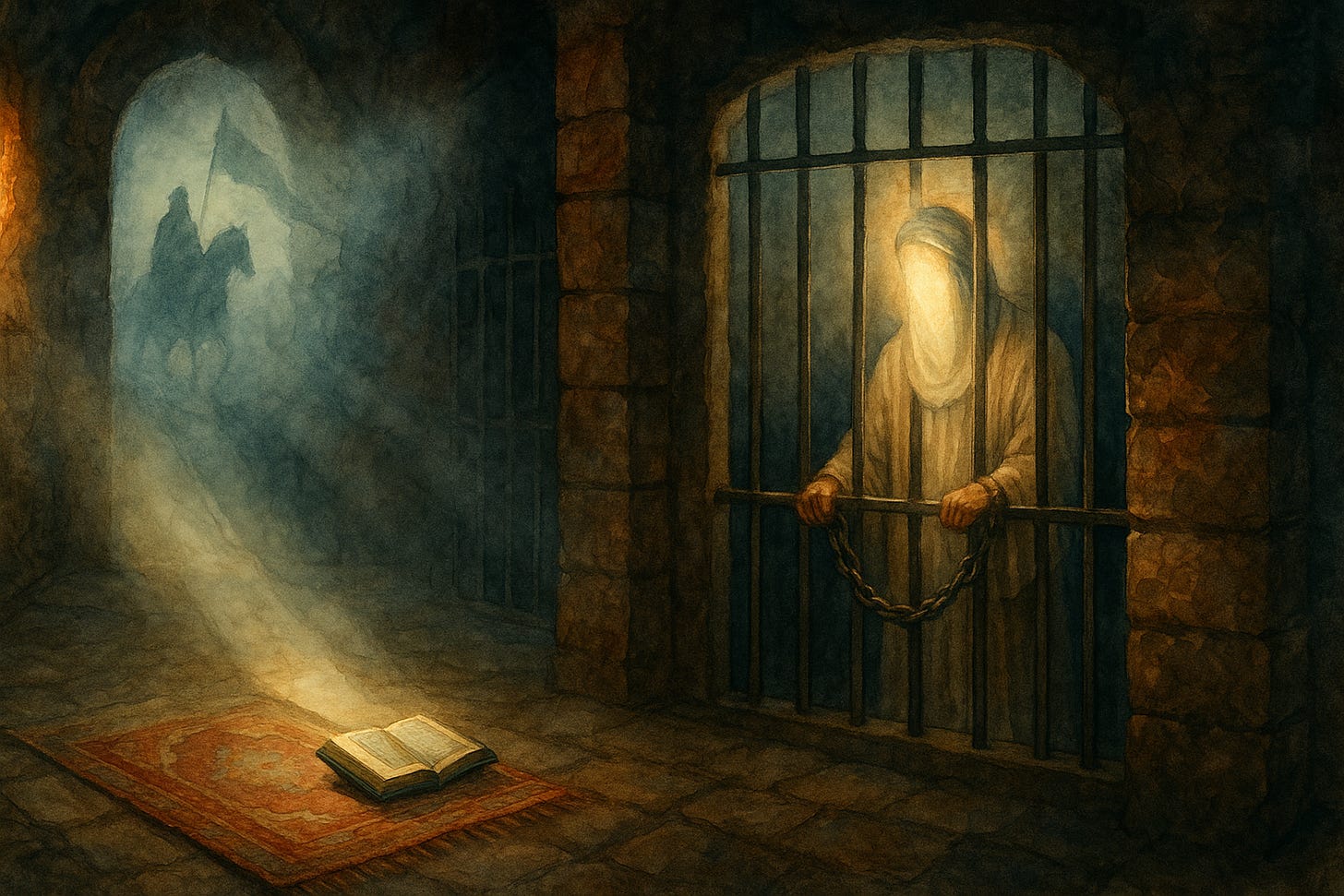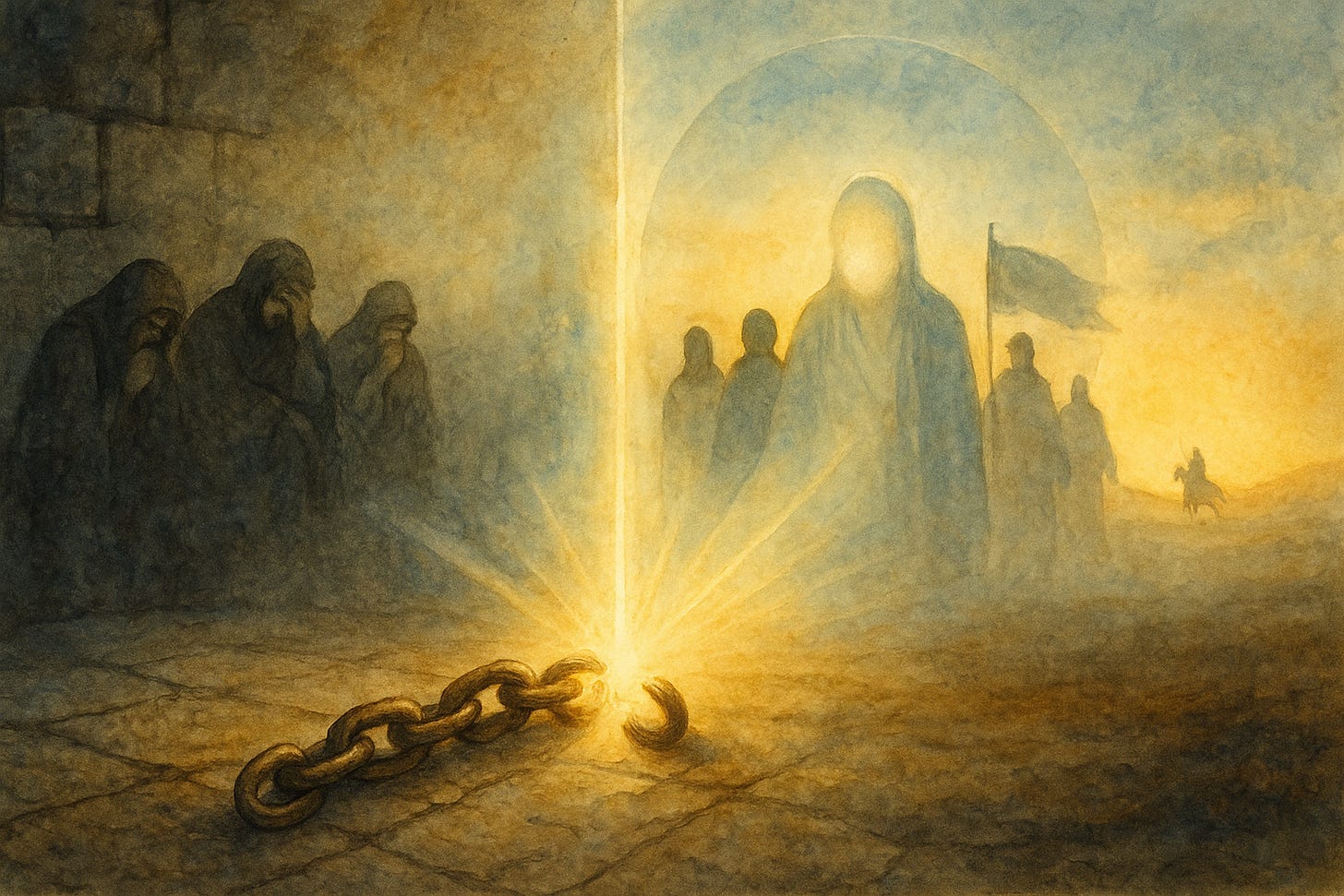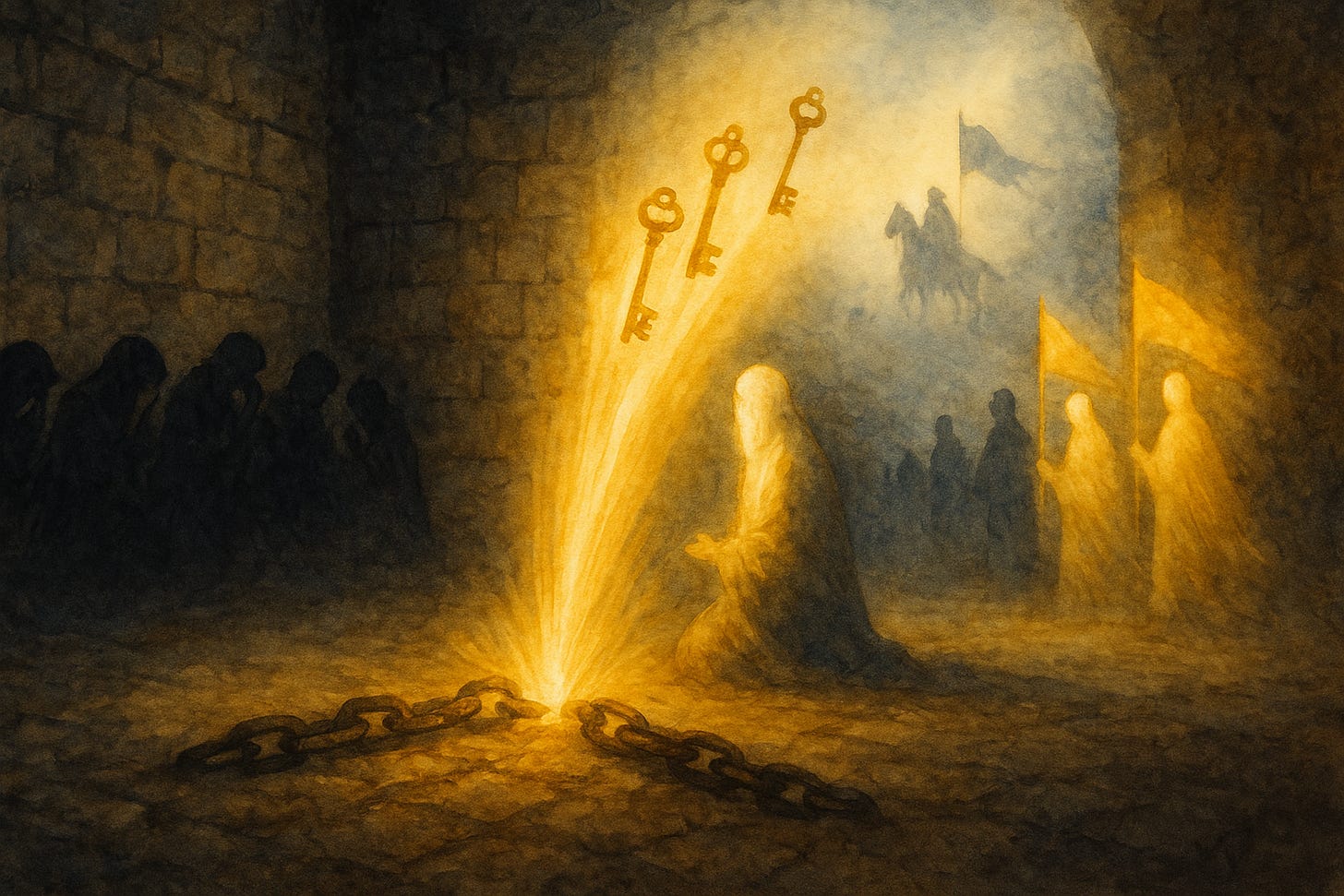[32] Imamah (Leadership) – Imam al-Kadhim: The Prisoner of Baghdad and the Lesson of Loyalty
A series of discussions on the teachings of Imam Sadiq (sixth Imam of the Muslims), from the book Misbah ash-Sharia (The Lantern of the Path)
In His Name, the Most High
This is part thirty-two of an ongoing series of discussions on the book attributed to Imam al-Sadiq entitled ‘Misbah ash-Sharia’ (the Lantern of the Path).
As is the case for each of the sessions in this series (and previous series), there is a requirement for the reader to at the very least take a cursory look at the previous sessions - though studying them properly is more beneficial - as the nature of this subject matter requires, a building up of understanding in a step by step manner.
Since each session builds on the one before, it is crucial that the previous sessions are studied - at least in a cursory manner, though fully is more beneficial - so we can try to ensure that misunderstandings and confusion do not ensue, as well as ensure we can garner more understanding from each session.
The previous parts can be found here:
Video of the Majlis (Sermon/Lecture)
This is the video presentation of this write-up as a Majlis (part of the Truth Promoters Weekly Wednesday Majlis Program)
Audio of the Majlis (Sermon/Lecture)
This is the audio presentation of this write-up as a Majlis (part of the Truth Promoters Weekly Wednesday Majlis Program)
Recap
Imam al-Sadiq: Commander of a Multi-Front Revolution
In our previous session, we turned a significant page in our journey through Imamate (Leadership), moving from the era of Imam Muhammad al-Baqir, the “Splitter of Knowledge,” to that of his son and successor, the sixth Imam, Imam Ja‘far al-Sadiq.
We saw how the father had meticulously prepared the ground, splitting open the earth of a dormant Ummah to reveal the pure springs of Prophetic wisdom.
It was his son who would turn those springs into a vast, flowing ocean.
We explored the volatile world Imam al-Sadiq inherited — a moment of transition, with the Umayyad dynasty rotting from within and the treacherous Abbasids rising under the false banner of Ahl al-Bayt.
This was the moment for which the Imams had been planning: the whispered revolution of Imam al-Sajjad and the foundational work of Imam al-Baqir were meant to culminate in an open uprising to establish a just government, with Imam al-Sadiq as the Qa’im (the one who will rise) of his time.
To understand his sacred mission, we examined the three interwoven dimensions of his struggle:
The Open Proclamation (al-Jihad)
Unlike his immediate predecessors, Imam al-Sadiq openly and publicly declared his right to the Imamate, directly challenging the legitimacy of both Umayyad and Abbasid tyrants — even proclaiming it on the plains of Arafat.
The Jihad of Clarification (al-‘Ilm)
We delved into his establishment of the great school of Madinah, which became the fortress of pure Islamic thought. By teaching authentic jurisprudence, he waged a calm but relentless jihad against the “governmental fiqh” of court scholars, who bent religion through qiyas (analogy) and istihsan (subjective preference) to sanctify corruption.
This was not mere scholarship but a political act of the highest order, preserving Islam from distortion.
The Hidden Organisation (al-Tanzim)
Beneath the public face of knowledge, Imam al-Sadiq commanded a vast, disciplined, and concealed network of believers.
This was the true Hizb Allah (Party of God), stretching across the Muslim world, sustained by the shield of taqiyyah (strategic prudence).
Taqiyyah here was no cowardice — it was revolutionary prudence: a shield that preserved the body of believers, and a hidden spear that allowed the truth to strike without exposing the hand that wielded it.
We traced this organisation back to the companions of Imam Ali, through the strategic patience of Imam Hasan, ignited by the sacrifice of Imam Husayn, and carefully rebuilt by Imams al-Sajjad and al-Baqir.
Imam al-Sadiq inherited and perfected this underground discipline, linking it with the economic independence of khums and anfal, and the doctrinal clarity of Imamah. In this way, he safeguarded both the survival of the Shia and the integrity of Islam.
Thus, we came to see Imam al-Sadiq not merely as a scholar, but as the commander of a multi-front revolution: a public jihad of proclamation, a scholarly jihad of clarification, and a hidden jihad of organisation — all working in unison to uphold the banner of true Imamate against the forces of tyranny.
With that foundation, our journey now turns to Imam Musa al‑Kadhim — the Imam of forbearance in chains, who carried the hidden organisation through prisons and surveillance and taught us how wilayah breathes even when the tongue is bound. This is the path we’ll open together in this session, God willing.
In His most beautiful name, and with a prayer that He help us to understand and follow the teachings and line of the Aimmah, we begin …
Imamah (Leadership) – Imam al-Kadhim: The Prisoner of Baghdad and the Lesson of Loyalty
The Imamate of Imam Musa al-Kadhim — Introduction and Historical Stage
After the luminous era of Imam Ja‘far al-Sadiq — the ocean of knowledge, the commander of the hidden organisation, the shield of taqiyyah (strategic prudence), and the wielder of the sword of tabyeen (clarification) — the mantle of divine leadership passed to his son, Imam Musa ibn Ja‘far al-Kadhim.
His Imamate spanned thirty-five years (148 to 183 AH), a period that must be counted among the most turbulent and perilous phases in the entire 250-year movement of the Imams.
The Holy Quran describes the principle that governs this succession of divinely appointed leaders:
وَجَعَلْنَا مِنْهُمْ أَئِمَّةً يَهْدُونَ بِأَمْرِنَا لَمَّا صَبَرُوا وَكَانُوا بِآيَاتِنَا يُوقِنُونَ
We made from among them Imams who guided by Our command when they were patient and had certainty in Our signs.
— Quran, Surah al-Sajdah (the Chapter of the Prostration) #32, Verse 24
This verse encapsulates the life of Imam Musa al-Kadhim: patience in chains, certainty in God’s promise, and unwavering guidance even from behind prison walls.
The Abbasid Landscape
The Imamate of al-Kadhim (peace be upon him) coincided with the reigns of four Abbasid rulers: al-Mansur, al-Mahdi, al-Hadi, and Harun al-Rashid. These were not weak or distracted rulers like the last Umayyads, nor were they vulnerable like the early Abbasids before consolidation.
By the time Imam al-Kadhim assumed leadership in 148 AH, the Abbasid throne had become entrenched, commanding vast resources and unprecedented stability.
Al-Mansur (d. 158 AH)
He crushed the uprisings of the Ahl al-Bayt’s Hasani cousins, massacring the descendants of Imam Hasan (peace be upon him) to the extent that their corpses were hidden in underground vaults — only discovered later as skeletons.
He poisoned Imam al-Sadiq (peace be upon him) to remove the threat of leadership, and then turned his surveillance apparatus against the young Imam al-Kadhim.
Al-Mahdi (158–169 AH)
He also pursued the same line, alternating between gestures of conciliation and hidden plots to annihilate the Imam.
It is narrated:
روي أن المهدي العباسي همّ بقتل موسى بن جعفر، فأخذ يستشيره بعض وزرائه في ذلك، فقال له: يا أمير المؤمنين، هذا ابن رسول الله، وليس مثلك من يقتل أمثاله، فصرفه الله تعالى عن عزمه.
It is narrated that al-Mahdi al-Abbasi intended to kill Musa ibn Ja‘far. He consulted some of his ministers regarding this, and one of them said to him: ‘O Commander of the Faithful, this man is the son of the Messenger of God, and it is not befitting for someone like you to kill one such as him.’ Thus God, the Exalted, turned him away from his intention.
— Al-Majlisi, Bihar al-Anwar, Volume 48, Page 112
— Al-Mufid, Al-Irshad, Volume 2, Page 225
— Al-Arbili, Kashf al-Ghumma, Volume 3, Page 9
— Al-Tabari al-Imami, Dala’il al-Imamah, Page 310
Al-Hadi (169–170 AH)
Al-Hadi was openly hostile, declaring his intent to “finish the matter of Musa ibn Ja‘far once and for all.”
قال الهادي العباسي: قد مضى زمان كنا نغضي عن بني هاشم، وإني عازم أن لا أترك منهم أحداً، وأول من أبدأ به موسى بن جعفر.
Al-Hadi al-Abbasi said: “The time has passed when we overlooked the Banu Hashim. I am resolved not to leave a single one of them, and the first with whom I shall begin is Musa ibn Ja‘far.”
— Al-Majlisi, Bihar al-Anwar, Volume 48, Page 112
— Al-Masoudi, Muruj adh-Dhahab wa Ma’adin al-Jawhar, Volume 3, Page 425
Harun al-Rashid (170–193 AH)
Harun al-Rashid al-Abbasi, combined cunning with ruthlessness. He projected piety and grandeur, but behind the curtain he saw in Imam al-Kadhim the greatest existential threat to Abbasid legitimacy.
Two narrations capture this vividly:
Harun al-Abbasi’s Visit to the Grave of Prophet Muhammad
لما دخل هارون الرشيد المدينة مضى إلى قبر النبي صلى الله عليه وآله فقال: السلام عليك يا رسول الله، السلام عليك يا ابن العم. فدنا موسى بن جعفر (عليه السلام) فقال: السلام عليك يا أبه. فقال هارون: هذا الفخر يا أبا الحسن.
When Harun al-Rashid entered Madinah, he went to the grave of the Prophet (peace and blessings be upon him and his family) and said: “Peace be upon you, O Messenger of God, peace be upon you, O cousin.”
Then (Imam) Musa ibn Ja‘far (peace be upon him) approached and said: “Peace be upon you, O my father.”
Harun replied: “This indeed is true honour, O Abu al-Hasan.”
— Al-Majlisi, Bihar al-Anwar, Volume 48, Page 144
— Al-Kulayni, Al-Kafi, Volume 8, Page 105
— Al-Saduq, Uyun Akhbar al-Ridha, Volume 1, Page 88
— Al-Mufid, Al-Irshad, Volume 2, Page 242
— Al-Arbili, Kashf al-Ghumma, Volume 2, Page 231
Harun al-Abbasi’s Conversation on Fadak
قال هارون لموسى بن جعفر (عليه السلام): حدّ لي فدكاً حتى أردها إليك. فأبى عليه الإمام، ثم قال: لا آخذها إلا بحدودها. قال: وما حدودها؟ قال: الحد الأول عدن، والثاني سمرقند، والثالث إفريقيا، والرابع سيف البحر مما يلي الجزر وأرمينية. فتغيّر وجه الرشيد وقال: فلم يبق لنا شيء. قال الإمام: قد أعلمتك أنّي إن حددتها لم تردها.
Harun said to Musa ibn Ja‘far (peace be upon him): “Define Fadak for me so that I may return it to you.”
The Imam at first refused, then said: “I will not take it except with its true boundaries.”
Harun asked: “And what are its boundaries?”
The Imam replied: “The first is Aden, the second is Samarqand, the third is Africa, and the fourth is the coastline up to the islands and Armenia.”
Harun’s face darkened, and he said: “Nothing remains for us, then.”
The Imam said: “I already told you — if I defined it, you would not return it.”
— Al-Majlisi, Bihar al-Anwar, Volume 48, Page 144
— Al-Saduq, Uyun Akhbar al-Ridha, Volume 1, Page 89
— Al-Kulayni, Al-Kafi, Volume 8, Pages 126-127
— Al-Ya’qubi, Tarikh al-Ya’qubi, Volume 3, Page 199
During this period, rebellions flared across the Islamic world — in Khorasan, Africa, Mosul, Daylam, Jurjan, Syria, Egypt, Azerbaijan, and Armenia — but each was suppressed.
The Abbasids not only secured their throne, but also filled their treasuries with the spoils of conquest and the wealth of the east and west.
The cultural sphere was likewise distorted.
Poetry, art, jurisprudence, and even asceticism were increasingly co-opted as instruments of court propaganda. Scholars in the pay of the caliphate produced fatwas (edicts/religious rulings) that sanctified tyranny; poets composed verses glorifying the Caliph; even zuhd (asceticism) was marketed as withdrawal from politics, rather than resistance to injustice.
Imam Khomeini (may God rest his pure soul) warned of precisely this danger centuries later, when he said:
وقتی تقوا از سیاست جدا شد، همان تقوایی که باید برای خدا باشد، میشود ابزار دست ستمگران.
When piety is separated from politics, that very piety which should be for God becomes a tool in the hands of oppressors.
— Imam Khomeini, Sahifa-ye Imam, Speech in Qum, January 11, 1979 (Dey 21, 1357), Volume 3, Page 432
The Imam’s Position
It was in this suffocating environment — where rebellion seemed impossible, the caliphate invincible, and even religion itself weaponised against truth — that Imam Musa al-Kadhim (peace be upon him) began his Imamate.
Unlike the fragile final years of the Umayyads, or the unstable first decade of the Abbasids, here the dynasty was secure, wealthy, and confident. There was no visible crack in the edifice of power.
And yet, the Abbasids knew — and feared — that the true alternative authority was alive.
As one of Harun’s own relatives admitted to him:
قال رجل من بني العباس لهارون: يا أمير المؤمنين، إن الناس يقولون: إنك خليفة، وموسى بن جعفر خليفة… لأن الناس يحملون إليك الخراج، ويقولون هذا حق أمير المؤمنين، ويحملون إلى موسى بن جعفر الخمس، ويقولون هذا حق الإمام.
A man from among the Abbasids said to Harun: “O Commander of the Faithful, the people say that you are the Caliph, and Musa ibn Ja‘far is also a Caliph… because the people bring kharaj (tax) to you and say this is the right of the Commander of the Faithful, and they bring khums to Musa ibn Ja‘far and say this is the right of the Imam.”
— Al-Tabarsi, al-Ihtijaj ‘ala Ahl al-Lijaj, Volume 2, Page 289
— Al-Majlisi, Bihar al-Anwar, Volume 48, Page 144
— Al-Mufid, Al-Irshad, Volume 2, Page 233
— Al-Kashshi, Rijal al-Kashshi, Pages 365-366
— Al-Tusi, Kitab al-Ghaybah, Pages 22-23
This was not empty rhetoric.
It reflected the reality that beneath the surface of Abbasid control lay a concealed, disciplined, and transnational network of loyalty to the Imam — a continuation of the hidden organisation built by his father.
The Imam’s Mission and Symbolism
In the private quarters of Imam Musa ibn Ja‘far al-Kadhim (peace be upon him), his companions noticed a striking and symbolic sight. One of his close confidants narrates:
دخلت على أبي الحسن موسى بن جعفر (عليه السلام) في بيته، فرأيت في حجرته ثلاثة أشياء: ثوب غليظ معلق لم يلبسه، وسيف معلق في السقف، ومصحف موضوع.
“I entered upon Abu al-Hasan Musa ibn Ja‘far (peace be upon him) in his house, and I saw in his chamber three things: a coarse garment hanging, not worn; a sword suspended from the ceiling; and a Quran placed before him.”
— Al-Majlisi, Bihar al-Anwar, Volume 48, Page 100
— Al-Saduq, Uyun Akhbar al-Ridha, Volume 1, Pages 90-91
— Al-Tabari al-Imami, Dala’il al-Imamah, Pages 273-274
Each of these objects was a declaration of his mission. The coarse garment represented the ascetic, revolutionary life of hardship and struggle he embraced. The sword symbolised jihad — not reckless violence, but the readiness to resist tyranny when God’s command permitted. The Quran was the goal itself: to establish a society guided by revelation, with justice and divine order at its heart.
The Quran itself testifies that these three are inseparable — revelation, balance, and force:
لَقَدْ أَرْسَلْنَا رُسُلَنَا بِالْبَيِّنَاتِ وَأَنزَلْنَا مَعَهُمُ الْكِتَابَ وَالْمِيزَانَ لِيَقُومَ النَّاسُ بِالْقِسْطِ ۖ وَأَنزَلْنَا الْحَدِيدَ فِيهِ بَأْسٌ شَدِيدٌ وَمَنَافِعُ لِلنَّاسِ وَلِيَعْلَمَ اللَّهُ مَن يَنصُرُهُ وَرُسُلَهُ بِالْغَيْبِ ۚ إِنَّ اللَّهَ قَوِيٌّ عَزِيزٌ
“Certainly We sent Our apostles with manifest proofs, and We sent down with them the Book and the Balance, so that mankind may maintain justice, and We sent down iron, wherein is great might and benefits for mankind, so that God may know who helps Him and His apostles, in secret. Indeed God is all-strong, all-mighty.”
— Quran, Surah al-Hadid (the Chapter of Iron) #57, Verse 25
Thus, from the very beginning of his Imamate, Imam al-Kadhim (peace be upon him) expressed through symbols that his mission was one of struggle, sacrifice, and the Quran.
The Most Difficult Beginning
Imam al-Kadhim’s Imamate began at one of the most difficult junctures of Shia history—rivalled only by the aftermath of Karbala in the time of Imam Zayn al-Abedeen (peace be upon him).
In the year 148 AH, the situation was dire:
Imam Ja‘far al-Sadiq (peace be upon him) had been martyred by poisoning at the order of the Abbasid caliph al-Mansur.
The Abbasids had crushed the uprisings of the Banu al-Hasan, slaughtering the descendants of Imam Hasan (peace be upon him) in such numbers that their corpses were hidden in underground chambers, later discovered as piles of bones.
Having settled its internal rivalries, the Abbasid caliphate was at the height of its stability, wealth, and surveillance.
It was in these suffocating conditions that the young Imam Musa al-Kadhim (peace be upon him) assumed the sacred trust. The danger was so acute that even identifying him as the successor could lead to death.
For this reason, Imam al-Sadiq (peace be upon him) concealed the matter through hints and strategic misdirection. When his trusted companion Mufaddal asked about the Imam who would follow him, Imam al-Sadiq replied indirectly:
قال الإمام الصادق (عليه السلام): قد جاء السلاح، ووضع على من هو أهله.
“The weapon has come, and it has been placed upon the one who is worthy of it.”
— Al-Majlisi, Bihar al-Anwar, Volume 48, Page 100
— Al-Kulayni, Al-Kafi, Volume 1, Kitab al-Hujjah (the Book of the Proofs), Page 231, Hadeeth 5
To be clear, the weapon being mentioned here is the weapon of the Prophet, and is a sign of his Imamate, as clarified further by Shaykh al-Saduq in Kamal ad-Din:
وإنّ السلاح فينا كسلاح رسول الله صلى الله عليه وآله، هو علامة الإمامة
And indeed the armour (prophetic weapon) with us is as the weapon of the Messenger of God, it is the sign of Imamate.
— Al-Saduq, Kamal ad-Din Wa Tamam al-Ni’mah, Volume 1, Page 311
And in al-Ghaybah of al-Nu’mani, we find:
السلاح فينا بمنزلة التابوت في بني إسرائيل، أينما كان السلاح يكون العلم
The weapon among us is like the Ark among the Israelites — wherever the weapon is, there is also the knowledge.
— Al-Nu’mani, Kitab al-Ghaybah, Page 104
In other reports, to conceal the truth from Abbasid spies, Imam al-Sadiq listed several names—including that of the caliph al-Mansur himself—before finally mentioning his son, Musa.
Imam al-Kadhim himself narrates:
عَنْ عَلِيِّ بْنِ جَعْفَرٍ قَالَ: سَأَلْتُ أَخِي مُوسَى بْنَ جَعْفَرٍ (ع) عَنِ الْوَاقِفَةِ وَمَا يَقُولُونَ، فَقَالَ (ع): "إِنَّ أَبِي لَمَّا حَضَرَتْهُ الْوَفَاةُ قَالَ: لَا تُحَدِّثُوا حَدِيثًا عَنِّي فَتَكْذِبُوا عَلَيَّ، فَإِنِّي أُشِيرُ إِلَى هَذَا وَهَذَا، وَإِنَّمَا الْخَلَفُ مِنْ بَعْدِي وَلَدِي هَذَا - وَأَشَارَ إِلَيَّ."
When my father was at the point of death, he said: ‘Do not circulate anything (definitive) about me lest you be accused of lying against me. For I will point to this one and to that one — but truly the successor after me is this son of mine,’ and he pointed towards me (Imam Musa al-Kadhim).
— Al-Kulayni, Al-Kafi, Volume 1, Kitab al-Hujjah (the Book of Proofs), Page 286, Hadeeth 8
Al-Mufid reports in Kitab al-Irshad, quotes Imam al-Sadiq as saying:
كَانَ أَبُو عَبْدِ اللَّهِ (ع) يَقُولُ: إِنَّمَا أُشِيرُ إِلَى بَعْضِ وُلْدِي لِلْتَّقِيَّةِ وَالحِفْظِ، وَالإِمَامُ بَعْدِي مُوسَى الْكَاظِمُ (ع)
When I point to some of my sons, it is only for the sake of taqiyyah and protection. But the Imam after me is Musa al-Kadhim (peace be upon him).
— Al-Mufid, Kitab al-Irshad, Volume 2, Pages 218 to 220
Imam al-Sadiq is also reported to have said:
عَنْ عَبْدِ الْأَعْلَى قَالَ: قَالَ أَبُو عَبْدِ اللَّهِ (ع):
قَدْ وُقِي أَبُو الْحَسَنِ (الإِمَامُ الكَاظِم) بِالْحِيلَةِ، إِنَّهُ إِذَا سُئِلْتُ فَقُلْتُ: هَذَا وَلَدِي، وَأَشَرْتُ إِلَى غَيْرِهِ، فَذَلِكَ مِنِّي لَهُ وِقَايَةٌ لَهُ وَلَكُمْ.Abd al‑Ala reported that Abu Abdillah (Imam al-Sadiq, peace be upon him) said:
“Abu al‑Hasan (Musa al-Kadhim) has been preserved by means of dissimulation. If I am asked [about my successor] and I say: ‘This is my son,’ while pointing to someone else, that is for his protection — for him and for you.”
— Al-Kulayni, Al-Kafi, Volume 1, Kitab al-Hujjah (the Book of Proofs), Page 285
And in al-Ghaybah of al-Nu’mani, we see find from Imam al-Sadiq:
إِنَّ أَبَا عَبْدِ اللَّهِ (ع) كَانَ يُشِيرُ إِلَى وُلْدِهِ فِي حَيَاتِهِ، فَيَقُولُ فِي بَعْضِ الْمَوَاطِنِ: هَذَا إِمَامُكُمْ، وَإِنَّمَا كَانَ يَفْعَلُ ذَلِكَ سِتْرًا عَلَى أَبِي الْحَسَنِ (ع).
Abu Abdillah (Imam al-Sadiq, peace be upon him) used to point to his children during his lifetime, and in some instances would say: ‘This is your Imam.’ But in truth he did this only to conceal Abu al‑Hasan (Musa al‑Kadhim).
— Al-Nu’mani, Kitab al-Ghaybah, Pages 105-106
Thus, from the very outset, a profound strategic prudence governed the Imamate of Imam al-Kadhim (peace be upon him), demanding both concealment and the careful practice of taqiyyah (strategic prudence).
He would warn his followers that their connection to him was dangerous and that simply being seen in his company could cost them their lives.
The Hidden Struggle and Taqiyyah (Strategic Prudence)
The Imamate of Imam Musa ibn Ja‘far al-Kadhim (peace be upon him) was characterised by concealment, networking, and the strategic use of taqiyyah (prudence).
In a time when the Abbasid caliphate seemed unshakable, the Imam preserved the underground movement of the Shia by guiding each supporter according to his position.
Ali ibn Yaqtin: Loyalty under Cover
Among the Imam’s most famous companions was Ali ibn Yaqtin, who held a high ministerial post in the Abbasid government under Harun al-Rashid.
Despite being in the very machinery of tyranny, he was a devoted follower of Imam al-Kadhim (peace be upon him).
The Imam commanded him to remain in his post, for his presence there was a shield for the Shia:
قال الإمام موسى الكاظم (عليه السلام) لعلي بن يقطين: كفارة عملك مع القوم، إحسانك إلى إخوانك.
Imam Musa al-Kadhim (peace be upon him) said to Ali ibn Yaqtin: “The expiation for your service among those people is that you show kindness to your brothers.”
— Al-Kashshi, Rijal al-Kashshi, Page 356, Hadeeth 659
— Al-Majlisi, Bihar al-Anwar, Volume 48, Page 127
Here the Imam demonstrated that service within an oppressive system could be tolerated only when it functioned as protection and support for the believers, not as collaboration with tyranny.
Safwan al-Jammal: Breaking Ties with Oppressors
On the other hand, the Imam condemned those whose work directly empowered the tyrant.
Safwan al-Jammal, a Shia who rented out his camels for Harun’s official journeys, once came to the Imam.
The Imam rebuked him:
يا صفوان! كل شيء منك حسن جميل ما خلا شيئا واحدا. قلت: جعلت فداك أي شيء؟ قال: كراءك جمالك لهذا الرجل يعني هارون. قلت: والله ما أكريته أشرا ولا بطرا ولا للصيد ولا للهو، ولكن أكريته لهذا الطريق. فقال (عليه السلام): أيقع كراؤك عليهم؟ قلت: نعم جعلت فداك. قال: أتحب بقاءهم حتى يخرج كراؤك؟ قلت: نعم. قال: فمن أحب بقاءهم فهو منهم، ومن كان منهم فهو وارد النار.
“O Safwan! Everything from you is good and beautiful except one thing.”
I said: “May I be your ransom, what is that?”
He said: “Your renting of your camels to this man” — meaning Harun.
I said: “By God, I do not rent them for pride, or vanity, or for hunting, or amusement, but only for this road.”
The Imam asked: “Does your payment fall upon them?”
I said: “Yes, may I be your ransom.”
He said: “Do you then wish for their survival until your rent is paid?”
I said: “Yes.”
The Imam said: “Whoever wishes for their survival is of them, and whoever is of them shall enter the Fire.”
— Al-Kashshi, Rijal al-Kashshi, Pages 356–357, Hadeeth 660
— Al-Majlisi, Bihar al-Anwar, Volume 48, Page 127
— Al-Saduq, Amali, Majlis 48, Hadeeth 11
— Al-Ameli, Wasail al-Shia, Volume 17, Page 182
— Al-Tusi, Amali, Majlis 12, Hadeeth 18
In this sharp admonition, the Imam made clear that even indirect support for tyranny is forbidden when it sustains their power.
The Quranic Basis of Taqiyyah
This strategy of concealment and prudence was firmly rooted in the Quran:
مَن كَفَرَ بِٱللَّهِ مِنۢ بَعْدِ إِيمَـٰنِهِ إِلَّا مَنْ أُكْرِهَ وَقَلْبُهُۥ مُطْمَئِنٌۢ بِٱلْإِيمَـٰنِ
“Whoever disbelieves in God after having believed — except for one who is compelled while his heart is at rest in faith…”
— Quran, Surah al-Nahl (the Chapter of the Bee) #16, Verse 106
The Prophet (peace and blessings be upon him and his family) explained this verse in the case of Ammar ibn Yasir, who was tortured until he uttered words of disbelief while his heart remained firm in faith.
Al-Tabrisi comments:
هذا يعفُّ عن الذي تكلم بلسانه بغير رضا قلبه.
“This verse absolves the one who spoke with his tongue against his will, while his heart did not consent.”
— Al-Tabrisi, Majma al-Bayan, Volume 2, Page 326
Fakhr al-Din al-Razi, a Sunni exegete, likewise wrote:
والذي يسمى بالتقية، بحيث يظهر للمضطر الكفر بلسانه ويبطن الإيمان بقلبه.
“This is what is called taqiyyah: when the compelled one outwardly displays disbelief by his tongue while inwardly holding to faith.”
— Fakhr al-Razi, Tafsir al-Kabir, Volume 8, Page 14
Imam Musa al-Kadhim (peace be upon him) himself declared - and this is also reported by Imam al-Sadiq, as we learned in the previous session:
التَّقِيَّةُ دِينِي وَدِينُ آبَائِي، وَلَا إِيمَانَ لِمَنْ لَا تَقِيَّةَ لَهُ.
“Taqiyyah is my religion and the religion of my forefathers. There is no faith for the one who has no taqiyyah.”
— Al-Saduq, al-Amali, Majlis 34, Page 222;
— Al-Majlisi, Bihar al-Anwar, Volume 75, Page 421
Taqiyyah is Not Deceit
It is critical to stress that taqiyyah is not a licence to lie, nor a form of deceit. This was explained in detail in the previous session, but since this is such an important point, let us revisit these critical points.
Islam condemns deception categorically, even in war.
The Quran says:
إِنَّ اللَّهَ لَا يَهْدِي كَيْدَ الْخَائِنِينَ
“Indeed, God does not guide the schemes of the treacherous.”
— Quran, Surah Yusuf (the Chapter of Joseph) #12, Verse 52
And the Messenger of God (peace and blessings be upon him and his family) said:
مَن غَشَّنَا فَلَيْسَ مِنَّا.
“Whoever deceives us is not of us.”
— Al-Kulayni, al-Kafi, Volume 5, Page 161, Hadeeth 3
An important clarifying hadeeth on taqiyyah, is from Imam al-Ridha, he teaches:
قَالَ الرِّضَا (ع):
التَّقِيَّةُ فِي الضَّرُورَةِ، وَلَا تَقِيَّةَ فِي إِظْهَارِ الْبَاطِلِ، وَإِذَا اسْتُعْمِلَتْ غَيْرَ مَوَاضِعِهَا فَهِيَ النِّفَاقُ.Imam al-Ridha said: “Taqiyyah is [only] in situations of necessity. There is no taqiyyah in manifesting falsehood. And if it is used outside its proper place, then it is hypocrisy.”
— Al-Saduq, Uyun Akhbar al-Ridha, Volume 2, Page 121
Thus, taqiyyah is not hypocrisy or dishonesty - as long as it is not misused, and indeed misusing it is a sin and brings the sinner into the state of hypocrisy.
It is strategic concealment under duress — when revealing one’s faith would lead only to destruction without benefit. The heart remains steadfast in belief, while the tongue withholds the truth until it can be spoken effectively.
When the moment comes — as with Imam Husayn (peace be upon him) at Karbala — taqiyyah is no longer permitted, for then the duty is to expose falsehood openly and sacrifice for truth.
This distinction must be clear: deceit is forbidden, while taqiyyah is prudence and survival.
One is betrayal; the other is strategy in the struggle for God.
Continuity from Imam al-Sadiq
In our previous session, we saw how Imam Ja‘far al-Sadiq (peace be upon him) institutionalised taqiyyah as both shield and spear — a revolutionary method, not cowardice.
He said:
اَلتَّقِيَّةُ تُرْسُ الْمُؤْمِنِ، وَالتَّقِيَّةُ حِرْزُ الْمُؤْمِنِ، وَلاَ إِيمَانَ لِمَنْ لاَ تَقِيَّةَ لَهُ.
“Taqiyyah is the shield of the believer, and taqiyyah is the safeguard of the believer. There is no faith for the one who has no taqiyyah.”
— Al-Kulayni, Al-Kafi, Volume 2, Page 217, Hadeeth 3
And we recalled the words of Imam Khamenei:
تقیه سپر است، دژ است، نجاتدهنده است و نیزهی مؤمن.
“Taqiyyah is the shield, the fortress, the saviour — and the spear of the believer.”
— Imam Khamenei, Ensan-e 250 Saleh (The 250 Year-Old Man), Page 276 to 277
Imam al-Kadhim (peace be upon him) carried forward this very method. His life itself was taqiyyah in action: concealing networks, protecting lives, guiding with wisdom — and at the same time, preparing the ground for the eventual exposure of Abbasid falsehood.
Contemporary Juristic Guidance
The principle Imam al-Kadhim embodied continues in the guidance of today’s jurists.
On Working with Tyrants
Firstly let us look at the principle of working with tyrants.
Imam Khamenei explains:
إذا كان وجود المؤمن في جهاز ظالم يؤدي إلى حفظ المؤمنين الآخرين وخدمة الدين، فهو جائز بل قد يكون واجباً. أما إذا كان وجوده يؤدي إلى تقوية الظالم، فهو حرام.
If the presence of a believer within the apparatus of a tyrant leads to the protection of other believers and service to the religion, then it is permissible, and at times may even be obligatory. But if his presence leads to strengthening the tyrant, then it is forbidden.
— Imam Khamenei, Ajwibah al-Istifta’at (Collected Fatwas), Volume 2, Page 541
Ayatullah Sayyid Ali al-Sistani similarly rules:
لا يجوز للمؤمن أن يعمل في أجهزة ظالمة إذا كان عمله يؤدي إلى دعم الظلم، وأما إذا كان عمله يؤدي إلى دفع الضرر عن المؤمنين أو خدمة مصالحهم، فلا بأس به.
It is not permissible for a believer to work within the institutions of oppressors if his work contributes to supporting oppression. But if his work contributes to averting harm from believers or serving their interests, then there is no problem in it.
— Ayatullah Sistani, Minhaj al-Salihin, Volume 1, Maslahah (Ruling) 1349
On Taqiyyah
Now, let us look at the rulings regarding taqiyyah:
Imam Khamenei explains on taqiyyah:
التقیة مشروعة بل واجبة إذا كان تركها يؤدّي إلى ضرر معتدّ به على النفس أو العرض أو المال، ولا تجوز إذا استلزمت إنكار الضروري من الدين أو تضييع أصل من أصوله.
Taqiyyah is legislated, indeed obligatory, if abandoning it leads to significant harm to life, honour, or property. It is not permissible if it requires the denial of an essential of religion or the compromise of a foundational principle.
— Imam Khamenei, Ajwibah al-Istifta’at (Collected Fatwas), Section of Taqiyyah, Question #38
Similarly, Ayatullah Sistani teaches:
التقيّة واجبة إذا خاف على نفسه، أو عرضه، أو ماله المعتدّ به من التلف أو النقص، بل تجب إذا كان في تركها حرج شديد لا يتحمّل عادة، إلاّ إذا أدّت إلى ترك فريضة أو إنكار ضروري من ضروريّات الدين.
Taqiyyah is obligatory if one fears for his life, honour, or considerable wealth from destruction or loss. In fact, it is obligatory if neglecting it would cause unbearable hardship. However, it is not permissible if it leads to abandoning a religious obligation or denial of an essential tenet of Islam.
— Ayatullah Sistani, Minhaj al-Salihin, Volume 1, Maslahah (Ruling) 1129
Through these contrasting instructions to Ali ibn Yaqtin and Safwan al-Jammal, Imam al-Kadhim (peace be upon him) clarified the practical application of taqiyyah: it is not an excuse for passivity or compromise, but a strategic method to safeguard the faith, preserve the community, and deny legitimacy to oppressors.
The Chain of Imams and Continuity
The Imamate of Imam Musa ibn Ja‘far al-Kadhim (peace be upon him) cannot be understood in isolation. It was the next link in a chain of resistance stretching across the centuries — from Imam Ali (peace be upon him) through Imam Hasan, Imam Husayn, Imam Zayn al-Abedeen, Imam al-Baqir, and Imam al-Sadiq (peace be upon them all).
Each carried the banner in his own way, suited to the conditions of his time.
Imam al-Sadiq (peace be upon him), knowing the suffocating surveillance of the Abbasids, often introduced his son Musa not with open proclamation but through hints and layered allegories.
To Mufaddal, he said:
قال الإمام الصادق (عليه السلام): قد جاء السلاح، ووضع على من هو أهله.
“The armour (prophetic weapon) has come, and it has been placed upon the one who is worthy of it.”
— Al-Majlisi, Bihar al-Anwar, Volume 48, Page 100
— Al-Kulayni, Al-Kafi, Volume 1, Page 308
— Al-Mufid, Al-Irshad, Volume 2, Page 211
— Al-Saduq, Kamal al-Din wa Tamam al-Ni’ma, Page 359-360
— Al-Tusi, Kitab al-Ghaybah, Page 67
To explain this further; in Shia thought, the term “al-silah” (the weapon/armour) is a coded reference not merely to physical arms or armour, but to the inheritance of Imamate - the sign of authority passed from one Imam to the next.
To Abd al-Rahman, he spoke similarly in metaphor, while to others he would list several names — including Mansur al-Abbasi, the governor of Madinah, and two women — before finally naming Musa ibn Ja‘far.
In this way, the identity of the Imam was protected from Abbasid spies, who sought to extinguish the line of succession at its root.
Imam al-Kadhim (peace be upon him) would live much of his life in concealment. At times, he was forced into hiding in distant villages of Syria or Tabaristan, even disguising himself so that his whereabouts were unknown.
One narration records:
وَقَعَ مُوسَى بْنُ جَعْفَرٍ (عليه السلام) فِي بَعْضِ قُرَى الشَّامِ هَارِباً مُتَنَكِّراً، فَوَقَعَ فِي غَارٍ، وَكَانَ فِيهِ رَاهِبٌ نَصْرَانِيٌّ، فَكَلَّمَهُ الْإِمَامُ حَتَّى أَسْلَمَ.
“Musa ibn Ja‘far (peace be upon him) was in some of the villages of Syria, fleeing in disguise, when he entered a cave. In it there was a Christian monk, and the Imam spoke with him until he embraced Islam.”
— Al-Majlisi, Bihar al-Anwar, Volume 48, Page 105
— Ibn Shahrashub, Manaqib Aal Abi Talib, Volume 4, Page 318
Such accounts reveal the lived reality of his Imamate: concealment, prudence, and struggle in every moment.
And in this, there is a foreshadowing of the great tribulation of the Shia during the occultation of the Awaited Imam, al-Mahdi (may our souls be his ransom and may God hasten his return).
Just as Imam al-Kadhim (peace be upon him) guided his followers while often hidden from their eyes, so too the Shia would one day be trained to preserve their faith without direct access to their Imam.
It can be argued that this was God’s preparation of the community for the long Greater Occultation, teaching them how to survive, organise, and remain loyal through taqiyyah and steadfastness.
The lessons of that era remain with us today: the more we embody them — building discipline, safeguarding the trust of wilayah, and resisting tyranny — the more we hasten the return of our beloved Imam al-Mahdi (may God hasten his return).
As the Imam Mahdi, may our souls be his ransom, himself wrote in his letter during the Minor Occultation:
وَأَكْثِرُوا الدُّعَاءَ بِتَعْجِيلِ الْفَرَجِ فَإِنَّ ذَلِكَ فَرَجُكُمْ.
“Increase your supplication for the hastening of the relief, for indeed that is your relief.”
— Al-Tusi, Kitab al-Ghaybah, Page 177 (attributed to Imam al-Sadiq)
— Al-Tabarsi, Al-Ihtijaaj, Volume 2, Page 497 (attributed to Imam Mahdi)
— Al-Majlisi, Bihar al-Anwar, Volume 53, Chapter on the Letters from the Imam, Page 181 (letter from Imam Mahdi to Muhammad ibn Uthman al-Amri, the second direct representative of Imam Mahdi)
The 250-Year Jihad (Struggle)
When viewed as isolated stories, the arrests, exiles, imprisonments, and debates of Imam al-Kadhim (peace be upon him) may appear disconnected.
But when placed in the broader arc of Shia history, they form a single chain: the 250-year jihad (struggle) of the Imams.
Their mission had three constant aims:
To explain pure Islam and the correct interpretation of the Quran.
To clarify the principle of Imamate and legitimate political authority.
To strive for the establishment of a just society — one that would realise the goals of the Prophet and all earlier messengers, uprooting idols from governance and placing authority in the hands of God’s chosen successors.
The Quran affirms this continuity:
وَلَقَدْ أَرْسَلْنَا نُوحًا وَإِبْرَٰهِيمَ وَجَعَلْنَا فِي ذُرِّيَّتِهِمَا النُّبُوَّةَ وَالْكِتَٰبَ فَمِنْهُم مُّهْتَدٍۢ وَكَثِيرٌ مِّنْهُمْ فَٰسِقُونَ
ثُمَّ قَفَّيْنَا عَلَىٰٓ ءَاثَٰرِهِم بِرُسُلِنَا وَقَفَّيْنَا بِعِيسَى ٱبْنِ مَرْيَمَ وَءَاتَيْنَٰهُ ٱلْإِنجِيلَ ۖ وَجَعَلْنَا فِي قُلُوبِ ٱلَّذِينَ ٱتَّبَعُوهُ رَأْفَةً وَرَحْمَةً…“Certainly We sent Noah and Abraham, and We placed [the gift of] prophethood and the Book among their descendants; among them are those who are guided, though many of them are transgressors. Then We sent Our apostles in their footsteps, and We sent Jesus son of Mary, and We gave him the Gospel, and We put compassion and mercy into the hearts of those who followed him…”
— Quran, Surah al-Hadid (the Chapter of the Iron) #57, Verses 26 to 27
Just as prophethood was preserved through successive messengers, so too the Imamate was preserved through successive Imams, each carrying the same struggle in different forms.
Imam Musa al-Kadhim (peace be upon him) devoted his life to this jihad. His teaching, his jurisprudence, his debates, his concealment, and even his imprisonment were all parts of the same mission: to guard the flame of divine authority until the appointed time.
The Confrontation with the Abbasids
We have already seen how the reigns of al-Mansur, al-Mahdi, al-Hadi, and Harun al-Rashid each brought Imam Musa ibn Ja‘far al-Kadhim (peace be upon him) into the crosshairs of Abbasid suspicion.
Those accounts gave us the historical stage.
Now, let us return to these same rulers to see how their encounters with the Imam were not isolated episodes, but decisive turning points that shaped the path to his imprisonment and eventual martyrdom.
Al-Mansur: Surveillance and Elimination
Al-Mansur had already poisoned Imam Ja‘far al-Sadiq (peace be upon him), and from the beginning of Imam al-Kadhim’s Imamate, his regime of surveillance sought to suffocate any possibility of open movement. The young Imam lived in constant danger, and his followers had to be introduced through allegory and concealment.
This climate of fear established the template for the entire Imamate of Musa ibn Ja‘far (peace be upon him).
Al-Mahdi: The Suspended Sword
We heard earlier how al-Mahdi al-Abbasi intended to kill Imam al-Kadhim (peace be upon him), only to be dissuaded by his own advisers:
روي أن المهدي العباسي همّ بقتل موسى بن جعفر، فأخذ يستشيره بعض وزرائه في ذلك، فقال له: يا أمير المؤمنين، هذا ابن رسول الله، وليس مثلك من يقتل أمثاله، فصرفه الله تعالى عن عزمه.
It is narrated that al-Mahdi al-Abbasi intended to kill Musa ibn Ja‘far. He consulted some of his ministers regarding this, and one of them said to him: ‘O Commander of the Faithful, this man is the son of the Messenger of God, and it is not befitting for someone like you to kill one such as him.’ Thus God, the Exalted, turned him away from his intention.
— Al-Majlisi, Bihar al-Anwar, Volume 48, Page 112
— Al-Mufid, Al-Irshad, Volume 2, Page 225
— Al-Arbili, Kashf al-Ghumma, Volume 3, Page 9
— Al-Tabari al-Imami, Dala’il al-Imamah, Page 310
This reprieve was not mercy — it was calculation.
Al-Mahdi recognised that the Imam’s blood would inflame the Ummah, and so he preferred to keep him under watch.
The lesson for us: sometimes the enemy does not strike because he is weak, but because he waits for the most strategic moment.
Al-Hadi: The Open Threat
Al-Hadi, in contrast, dispensed with subtlety. He declared openly:
قد مضى زمان كنا نغضي عن بني هاشم، وإني عازم أن لا أترك منهم أحداً، وأول من أبدأ به موسى بن جعفر.
“The time has passed when we overlooked the Banu Hashim. I am resolved not to leave a single one of them, and the first with whom I shall begin is Musa ibn Ja‘far.”
— Al-Majlisi, Bihar al-Anwar, Volume 48, Page 112, Hadeeth 2
— Al-Mufid, Al-Irshad, Volume 2, Page 231
— Al-Fadl al-Tabrisi, Ilam al-Wara' bil Alam al-Huda, Page 316
— Ibn Shahrashub, Manaqib Aal Abi Talib, Volume 4, Page 338
— Al-Arbili, Kashf al-Ghumma Fi Ma’rifat al-Aimmah, Volume 2, Page 223
And yet, God’s providence intervened. One of the jurists of his court stood before him and dared to speak:
فقام إليه بعض الفقهاء، وقال: يا أمير المؤمنين، بالله عليك أن تراقب الله في ذرية نبيه، فإن هذا موسى بن جعفر من أولاد رسول الله (ص). فتركه.
Then one of the jurists rose and said: “O Commander of the Faithful, I urge you by God to fear God regarding the descendants of His Prophet, for this Musa ibn Ja‘far is of the children of the Messenger of God (peace be upon him and his family).”
So al-Hadi left him.
— Al-Majlisi, Bihar al-Anwar, Volume 48, Page 112, Hadeeth 2
— Al-Mufid, Al-Irshad, Volume 2, Page 231
— Al-Fadl al-Tabrisi, Ilam al-Wara' bil Alam al-Huda, Page 316
— Al-Arbili, Kashf al-Ghumma Fi Ma’rifat al-Aimmah, Volume 2, Page 223
This was no longer surveillance or hesitation; it was the Abbasid state announcing that the Imam must be eliminated.
Only providence, and the courage of a jurist who feared God more than the caliph, saved the Imam from immediate execution at this point.
Even in the darkest of courts, God raised a voice to protect His Proof upon the earth.
Harun al-Rashid: From Pretence to Prison
The encounters of Harun al-Rashid with Imam al-Kadhim (peace be upon him) — his visit to the Prophet’s grave, and his conversation on the boundaries of Fadak — we heard earlier as moments of sharp defiance. But they were more than rhetorical victories; they were turning points.
At the Prophet’s grave, the Imam exposed the emptiness of Harun’s claim to kinship, reminding the Ummah that true succession runs through the Prophet’s household:
فدنا موسى بن جعفر (عليه السلام) فقال: السلام عليك يا أبه. فقال هارون: هذا الفخر يا أبا الحسن.
Then Musa ibn Ja‘far (peace be upon him) approached and said: “Peace be upon you, O my father.” Harun replied: “This indeed is true honour, O Abu al-Hasan.”
— Al-Majlisi, Bihar al-Anwar, Volume 48, Page 144
— Al-Kulayni, Al-Kafi, Volume 8, Page 105
— Al-Saduq, Uyun Akhbar al-Ridha, Volume 1, Page 88
— Al-Mufid, Al-Irshad, Volume 2, Page 242
— Al-Arbili, Kashf al-Ghumma, Volume 2, Page 231
In the debate over Fadak, the Imam declared that its true boundaries encompassed the entire Islamic dominion — Aden, Samarqand, Africa, and the Mediterranean.
Harun understood immediately: to concede Fadak was to concede the caliphate itself.
Thus, what appeared as exchanges of words were in fact moments when Harun saw, with clarity, that Musa ibn Ja‘far was not only a saintly scholar but the living claimant to political sovereignty.
From that point on, Harun’s course hardened: the Imam had to be imprisoned, silenced, and ultimately removed.
The Abbasids’ Fear
Even Harun’s own family admitted the truth:
قال رجل من بني العباس لهارون: يا أمير المؤمنين، إن الناس يقولون: إنك خليفة، وموسى بن جعفر خليفة… لأن الناس يحملون إليك الخراج، ويقولون هذا حق أمير المؤمنين، ويحملون إلى موسى بن جعفر الخمس، ويقولون هذا حق الإمام.
A man from among the Abbasids said to Harun: “O Commander of the Faithful, the people say that you are the Caliph, and Musa ibn Ja‘far is also a Caliph… because the people bring kharaj (tax) to you and say this is the right of the Commander of the Faithful, and they bring khums to Musa ibn Ja‘far and say this is the right of the Imam.”
— Al-Tabarsi, al-Ihtijaj ‘ala Ahl al-Lijaj, Volume 2, Page 289
— Al-Majlisi, Bihar al-Anwar, Volume 48, Page 144
— Al-Mufid, Al-Irshad, Volume 2, Page 233
— Al-Kashshi, Rijal al-Kashshi, Pages 365-366
— Al-Tusi, Kitab al-Ghaybah, Pages 22-23
This acknowledgement explains why Harun never felt secure as long as Imam al-Kadhim lived.
Behind the prison walls, chained and silenced, the Imam was still more feared than any army — because he was the true pole of loyalty in the Ummah.
The Imprisonment and Martyrdom of Imam Musa al-Kadhim
The Successive Imprisonments
The Abbasid response to Imam Musa ibn Ja‘far al-Kadhim (peace be upon him) reached its peak under Harun al-Rashid. Knowing that killing him openly would unleash fury, Harun opted for gradual suffocation — exile, interrogation, and above all, imprisonment.
The Imam was transported multiple times between Madinah, Basra, and Baghdad. At times he was held under the custody of governors; at others, under the brutal jailers of Harun’s palace.
Eventually, he was confined in the house of Sindi ibn Shahak, one of the most infamous jailers of the Abbasid state.
Even there, the Imam’s light could not be extinguished.
One narration states:
كان موسى بن جعفر (عليه السلام) في بيت السندي بن شاهك، وكان له في البيت كُوَّةٌ يشرف منها عياله عليه، فكانوا يرون عبادته وصلاته بالليل والنهار، فيتأثرون به، حتى إن بعض ولده أحبّوه، وصاروا من شيعته.
Musa ibn Ja‘far (peace be upon him) was confined in the house of Sindi ibn Shahak. There was a small window through which Sindi’s family could see him. They would witness his worship and prayer night and day, and they were moved by him, until some of Sindi’s own children came to love him and became of his Shia.
— Al-Majlisi, Bihar al-Anwar, Volume 48, Page 235
— Al-Arbili, Kashf al-Ghumma, Volume 2, Page 243
— Al-Mufid, Al-Irshad, Volume 2, Pages 247-249
— Sayyed Ibn Tawus, Faraj al-Mahmoum, Pages 173-174
This is the paradox of the Imam’s imprisonment: though chained, he became a beacon, turning even the household of his jailer towards the love of Ahl al-Bayt.
Finally, the Abbasids resolved to end his life.
Sindi ibn Shahak brought prominent figures of Baghdad to “witness” that the Imam was in good health.
The Imam, however, declared to them plainly:
إنهم سمّوني في سبع تمرات وأنا غداً أمضي شهيداً.
“They have poisoned me in seven dates, and tomorrow I shall depart as a martyr.”
— Al-Mufid, al-Irshad, Volume 2, Page 241
— Al-Tabrisi, Ilam al-Wara, Page 322
— Al-Arbili, Kashf al-Ghumma, Volume 2, Page 245
— Al-Majlis, Bihar al-Anwar, Volume 48, Pages 238-239
The Imam’s Martyrdom and the Proclamation of “Rafidha”
Shortly thereafter, Imam Musa al-Kadhim (peace be upon him) was martyred in chains. To erase suspicion of foul play and to humiliate the Shia, Harun al-Rashid ordered that his body be exposed publicly:
أمر هارون الرشيد أن يُوضَع جسد موسى بن جعفر (عليه السلام) على جسر بغداد، ونُودي عليه: هذا إمام الرافضة، فليشهد الناس أنه قد مات.
Harun al-Rashid ordered that the body of Musa ibn Ja‘far (peace be upon him) be placed on the bridge of Baghdad, and it was proclaimed:
“This is the Imam of the Rafidha, so let the people bear witness that he has died.”
— Al-Majlisi, Bihar al-Anwar, Volume 48, Page 256
— Shaykh al-Tusi, al-Ghaybah, Page 30
— Al-Mufid, Al-Irshad, Volume 2, Pages 249-250
— Al-Tabrisi, Ilam al-Wara, Page 323
— Al-Arbili, Kashf al-Ghumma, Volume 2, Page 247
The proclamation was meant to declare the Abbasids’ triumph over the Shia, branding them with the word Rafidha.
The Meaning of “Rafidha”: A Badge of Honour, A Call to Unity
The term Rafidha, literally meaning “those who refuse,” carries a deep and often contested history.
Historically, it was hurled at the Shia because they refused to give allegiance to rulers they considered illegitimate after the Prophet Muhammad (peace and blessings be upon him and his family).
Instead, they insisted upon the rightful leadership of the Ahl al-Bayt (the Prophet’s household).
During the Abbasid period, this term was weaponised as an official slur — a political tool to delegitimise the Shia and cast them as outcasts, the “rejecters of the Ummah.” By labelling a revered figure like Imam Musa al-Kadhim (peace be upon him) as the “Imam of the Rafidha,” the caliph Harun al-Rashid sought to isolate him and portray his followers as disloyal rebels.
However, the Imams of the Ahl al-Bayt masterfully reclaimed this pejorative term, transforming it into a symbol of pride. Imam Ja‘far al-Sadiq (peace be upon him) reframed its meaning:
والله ما هم سمّونا، ولكن الله سمّانا. إنما سمّانا الرافضة لأنّا رفضنا الباطل، وأخذنا بالحق.
“By God, it was not they who named us, but Allah who named us. They called us Rafidha because we rejected falsehood (al-batil) and upheld the truth (al-haq).”
— Al-Kulayni, al-Kafi, Volume 8, Page 217;
— Al-Saduq, Ilal al-Shara’i, Volume 1, Page 119;
— Al-Majlisi, Bihar al-Anwar, Volume 65, Page 96.
Thus, what began as an insult became a badge of honour. To be a Rafidhi, in this true sense, is to refuse oppression, to reject tyranny, and to stand firm with truth.
The Term in Modern Times: A Weapon of Division
From Abbasid Baghdad to the modern era, the enemies of the Ahl al-Bayt have continued to wield this term as a weapon.
Wahhabi polemicists and takfiri groups, such as al-Qaeda and Daesh/ISIS, have revived it in their violent rhetoric, using it to dehumanise the Shia and justify bloodshed.
And yet, the meaning taught by the Imams remains true: every time the enemies of justice call us Rafidha, they unwittingly affirm that the true followers of the Ahl al-Bayt are those who reject their falsehood and stand for divine truth, no matter the cost.
A Critical Clarification: Rejecting Sectarianism
It must also be said that, regrettably, some extremist individuals and sectarian groups who identify as Shia have misused terms like “Rafidhi” in a way that fuels hostility towards other Muslims.
This is a betrayal of the teachings of the Ahl al-Bayt. The Imams rejected falsehood and injustice — not their fellow Muslims.
Our contemporary scholars have spoken clearly on this matter.
Imam Khamenei issued a historic fatwa:
إهانةُ رموز إخواننا السنة، ومنهم زوجةُ النبي الأعظم صلى الله عليه وآله، حرام.
Insulting the symbols of our Sunni brothers, including the wife of the Greatest Prophet (peace be upon him and his family), is forbidden.
— Imam Khamenei, Fatwa on Insulting Sunni Sanctities, September 30, 2010, via Majmu’ah Istifta’at Jadidah, Volume 1
Ayatollah Sistani has likewise emphasised:
السنةُ أُمةٌ منّا ونحن منهم، وحياتُهم وأموالُهم وأعراضُهم حرامٌ كحياتِنا وأموالِنا وأعراضِنا.
The Sunnis are part of us and we are part of them; their lives, wealth, and honour are inviolable, just as our lives, wealth, and honour are inviolable.
— Ayatollah Sistani, Fatwa on Takfir and Unity, Najaf, 2015, via Fatawa wa-Irshadat al-Sayyid al-Sistani fī al-Mashahed al-Iraqiyya, Pages 77-78, Section on Muqawamat al-Takfir
Both insist that Islamic unity is a divine obligation.
Unity Does Not Mean Uniformity
This call for unity is not a call for uniformity.
It does not mean abandoning theological principles or dissolving the diversity of Islamic thought.
Rather, it means recognising our shared faith, respecting differences, and uniting against the true enemies of Islam: ignorance, oppression, injustice, and colonial/imperialist powers that exploit sectarian strife.
As Imam Khamenei has said elsewhere:
الوحدة لا تعني أن يتنازل المسلمون عن عقائدهم، بل تعني أن يتكاتفوا في وجه العدو المشترك، ويحفظوا حرمة بعضهم البعض.
Unity does not mean that Muslims must abandon their beliefs, but that they must stand together against the common enemy and preserve respect for one another.
— Imam Khamenei, Speech to Islamic Unity Conference, Tehran, October 19, 2010
The True Meaning Today
Ultimately, the true spirit of a Rafidhi is not found in sectarian slurs or divisive rhetoric.
It is embodied in the principled rejection of falsehood — whether political tyranny, social injustice, or religious extremism that seeks to divide the Ummah.
It is a commitment to uphold the truth with wisdom, courage, and a profound sense of unity.
Beyond Ritual: The Deeper Meaning of Loyalty
The story of Imam al-Kadhim's imprisonment is not just a tragedy inflicted by an oppressor. The school of the Ahl al-Bayt teaches us that every historical event is a mirror for our own souls. It forces us to ask not only 'What did the tyrant do?' but also, 'What did the believers do?'
When we look at our communities today, we see a sea of love for the Ahl al-Bayt. We see it in the tears we shed for Imam Husayn. We see it in the millions who walk to Karbala for Arbaeen, with aching feet but hearts full of devotion.
This love is pure, it is beautiful, and it is a great treasure.
But the Imams always call us to elevate that love. They want us to transform that profound emotion into profound awareness and principled action. The remembrance of the past must illuminate our duty in the present.
It's from this exact place of concern—of wanting our community's pure love to reach its fullest potential—that a scholar of our time, Sayyed Hashem al-Haidari, holds up the mirror of Imam al-Kadhim's history. He asks a difficult, even painful, but absolutely essential question. He looks back at that time and challenges us with these words:"
Sayyed Hashem al-Haidari reminds us that the tragedy of the Imam’s imprisonment is not only what the Abbasids did, but what the Shia failed to do.
He says:
سبع سنوات الامام الكاظم بالسجن اين شيعته؟
كانوا يذهبون مشيا الى كربلاء وحسين الحقيقي في السجن.
اليس هذا تاريخنا؟
اين الشيعة؟
فقط حارسين كانوا على السجن، لم يذهب احد ليخلص الامام الا ثلة قليلة.
الامام قال لهم: انتم مغلوب على امركم اسكتوا.
وهارون الرشيد في القصر الجمهوري والامام الكاظم في السجن سبع سنوات، سبع محرمات، سبع أربعينيات، الى ان قتل الامام ووضعه هارون الرشيد على الجسر وقال:
هذا امام الرافضة.
نعم، هنا جاءت الشيعة، شنو تشيع؟
تنصب چادر. هذا تاريخنا وكربلاء تشهد على ذلك.
For seven years, Imam al-Kadhim was in prison.
Where were his Shia?
They would go on foot to Karbala while their real Husayn was in prison.
Is this not our history?
Where were the Shia?
There were only two guards at his cell, yet none came to free him except a handful.
The Imam told them: ‘You are overpowered in your affairs, so remain silent.’
Meanwhile, Harun al-Rashid was in his palace, and Imam al-Kadhim was in prison for seven years — seven Muharrams, seven Arbaeen’s — until the Imam was killed, and Harun placed him on the bridge saying:
‘This is the Imam of the Rafidha.’
Yes, then the Shia came out. For what?
To put up black cloths. This is our history, and Karbala bears witness to it.
— Sayyed Hashem al-Haidari, Karbala is a Witness (speech, Baghdad).
Let us be clear. This is not a condemnation of our ziyarat or our tears. It is a searing call to ensure our rituals are not an escape from our responsibilities, but the very fuel for them.
Sayyed Hashem is asking us, with the love of a brother, to connect our hearts for the Husayn of 61 AH with our loyalty to the Husayn of our own time.
He is reminding us that the deepest tragedy was not just the chains placed on the Imam by his enemy, but the silence of a community that was busy with rituals while its living leader languished in a dungeon.
Sayyed Hashem al-Haidari’s speech is a searing reminder: devotion in ritual, ziyarat, and mourning cannot substitute for loyalty to the Imam of one’s own time.
To abandon the living Imam while mourning the dead Imam is a betrayal.
The Imam’s critical instruction to the few who did come, “You are overpowered in your affairs, so remain silent,” reveals both his compassion for their weakness and his pain at their collective inaction. This statement is a well-documented historical report (hadeeth), recorded in several classical sources:
أنتم مغلوبون على أمركم فاصمتوا.
“You are overpowered in your affairs, so remain silent.”
— Al-Majlisi, Bihar al-Anwar, Volume 48, Page 147
— Al-Saffar, Basa’ir al-Darajat, Page 483, Hadeeth 6
— Al-Ayyashi, Tafsir al-Ayyashi, Volume 2, Page 109
— Al-Kulayni, Al-Kafi, Volume 8, Page 147, Hadeeth 225
Lessons for the Ghaybah and Our Time
The imprisonment of Imam al-Kadhim was a divine rehearsal for the greater trial of the Shia: the Occultation of Imam al-Mahdi (may our souls be his ransom and may God hasten his return).
In prison, the Imam was alive yet hidden, guiding from behind walls.
In occultation, the Imam is alive yet hidden, guiding from behind veils.
In both cases, the test is the same: will the Shia remain loyal in his absence, or will they busy themselves with rituals while neglecting his cause?
The Quran warns us of the danger of empty worship divorced from justice:
أَرَأَيْتَ الَّذِي يُكَذِّبُ بِالدِّينِ
فَذَٰلِكَ الَّذِي يَدُعُّ الْيَتِيمَ
وَلَا يَحُضُّ عَلَىٰ طَعَامِ الْمِسْكِينِ
فَوَيْلٌ لِّلْمُصَلِّينَ
الَّذِينَ هُمْ عَن صَلَاتِهِمْ سَاهُونَ
الَّذِينَ هُمْ يُرَاءُونَ
وَيَمْنَعُونَ الْمَاعُونَ.Have you seen the one who denies the religion?
That is the one who repulses the orphan, and does not encourage the feeding of the poor.
So woe to those who pray — those who are heedless of their prayers, those who make a show, yet withhold the simplest acts of kindness.— Quran, Surah al-Ma’un (the Chapter of Small Kindnesses) #107, Verses 1 to 7
The warning is clear: prayer without justice, mourning without loyalty, ritual without resistance — these become hollow acts.
Sayyed Hashem al-Haidari drives the lesson home for today:
اذا علينا اليوم اليوم ان نعرف حسينا ونعرف شمر زماننا. مو فقط نعرف الحسين، نعرف شمر زماننا. اما اذا كان ميزاننا وملاك ومعيارا للانسان الحسين العاشورائي الفاظ فقط ومشاعر فقط وشعائر فقط فبلا شك هكذا امه قد تزور الحسين في حر وضريحه وقد تمسك بالضريح وتقبل الضريح ولكنها في نفس الوقت قد تحمل السيف ضد من ينصر الحسين ويرفع رايه الحسين.
Therefore, today we must know our Husayn and also know the Shimr of our time. Not only know Husayn, but also the Shimr of our time. But if our measure and standard of being Husayni is only words, only emotions, only rituals, then without doubt such a nation may visit Husayn at his shrine, may hold and kiss the shrine, but at the same time may carry the sword against those who truly support Husayn and raise the banner of Husayn.
— Sayyed Hashem al-Haidari, Karbala is a Witness (speech, Baghdad).
Thus the prison of Baghdad is not merely history; it is a mirror. Just as Karbala exposed the people of Kufa, the chains of Imam al-Kadhim expose us.
If we do not live as people of sacrifice, discernment, and resistance, then we are not preparing for the Imam of our age. But if we embody these qualities, we hasten the return of Imam al-Mahdi (may our souls be his ransom and may God hasten his return), of whom the Imam himself wrote:
وَأَكْثِرُوا الدُّعَاءَ بِتَعْجِيلِ الْفَرَجِ فَإِنَّ ذَلِكَ فَرَجُكُمْ.
“Increase your supplication for the hastening of the relief, for indeed that is your relief.”
— Al-Tusi, Kitab al-Ghaybah, Page 177 (attributed to Imam al-Sadiq)
— Al-Tabarsi, Al-Ihtijaaj, Volume 2, Page 497 (attributed to Imam Mahdi)
— Al-Majlisi, Bihar al-Anwar, Volume 53, Chapter on the Letters from the Imam, Page 181 (letter from Imam Mahdi to Muhammad ibn Uthman al-Amri, the second direct representative of Imam Mahdi)
Supplication as a Catalyst for Action
The Imam’s command to "increase your supplication" is not an invitation to passive hope, but a call to active participation. True supplication (dua) -- as we discuss in our The Art of Supplication series — is meant to be a transformative act; it should awaken the soul of the supplicant and ignite a profound desire for self-improvement and change.
This principle is most critical when we supplicate for ‘the relief’ (al-Faraj). To beg God to hasten the Imam's return is not merely to sit and wait for divine intervention.
Rather, the prayer itself is a pledge.
It is a commitment to rise and actively pave the way for his arrival.
This means the plea on our lips must be matched by the striving of our limbs.
We ask for his return while working to become worthy of his presence—by establishing justice in our own lives, seeking knowledge, purifying our intentions, strengthening our communities, enjoining good, forbidding evil, and encouraging patience - though active patience, as we have discussed in our series on patience.
The supplication for his relief is, therefore, a supplication that God grants us the tawfiq (success/ability) to become His true agents of change.
Our prayer for him becomes the very blueprint for our own action.
Conclusion
The life of Imam Musa ibn Ja‘far al-Kadhim (peace be upon him) stands as one of the most painful yet most illuminating chapters in the 250-year jihad of the Imams.
Thirty-five years of vigilance, chains, concealment, and unbroken resolve — every step marked by struggle, every breath filled with the remembrance of God.
His Imamate teaches us that even in the face of unassailable tyranny, when the caliphate appears invincible and religion itself is co-opted into propaganda, the Imam is the living proof of God, guiding by His command. Chains cannot silence him, prisons cannot extinguish his light, and slander cannot erase his truth.
Yet his imprisonment also reveals a tragedy: that many of his followers were content to mourn Husayn while abandoning the Husayn of their own time.
Sayyed Hashem al-Haidari’s cry echoes across centuries: ritual without loyalty is betrayal, prayer without justice is hypocrisy, mourning without sacrifice is emptiness.
This is the mirror held up to us in the age of occultation.
Just as the Shia were tested in the absence of their Imam behind prison walls, so we are tested in the absence of our Imam behind the veils of ghaybah. The same lessons apply: to reject falsehood, to safeguard the trust of wilayah, to be people of sacrifice and insight, and to prepare the ground for the Imam’s return.
In our next session, we will turn to the life of Imam Ali al-Ridha (peace be upon him), whose era introduces one of the most misunderstood chapters of Shia history: the heir-apparency offered by Ma’mun al-Abbasi. We will clarify the reality of this episode, its divine wisdom, and how it fits into the grand map of the Imams’ 250-year movement.
A Supplication-Eulogy for Imam al-Kadhim - Chains of Light, Keys of Loyalty
In the Name of God, the All-Merciful, the All-Compassionate.
O God, send Your blessings upon Muhammad,
and the family of Muhammad—
lanterns in the deepest darkness,
mines of Your wisdom,
and witnesses against every oppressor.O Musa ibn Ja‘far,
Ya Kadhim al-Ghaydh!
O tranquil soul who swallowed your anger until it became a sea of forbearance.
Peace be upon you, O noble Imam in chains.
Peace be upon you, O solitary prisoner of Baghdad.
Peace be upon you, O true inheritor of Husayn’s sublime patience.
Peace be upon you, O patient forerunner of the awaited occultation.They sought to extinguish Your light with the poison of shadows and the darkness of dungeons.
They placed your earthly form upon the bridge, a spectacle for the cruel, a lesson in humiliation.
Yet Your divine light could not be contained, piercing the hearts of your very jailers.
Though abandoned by the many who feared, the few who clung to your guidance were guided to an immortal truth.O our Master, we come to you with heads bowed, confessing:
How often have we mourned for Karbala, yet neglected the Husayn of our own time?
How often have we perfected our rituals, yet remained deaf to the cries of the oppressed?
Forgive our distracted hearts, O Imam.
Teach us the meaning of true loyalty—
a loyalty that sees, that acts, that endures.O God, by the sanctity of Your imprisoned friend, do not let us be among those who abandon the living Imam.
Instead, make us active preparers for the Imam of our Age, the awaited hope, the son of Fatimah—al-Mahdi (may our souls be his ransom, and may You hasten his return).
O God, hasten his return, and make us worthy of his presence.
Raise us among his helpers, his martyrs, and his steadfast companions.O God, by his truth, make us true Rafidha — firm rejecters of every falsehood and every tyrant, yet never rejecters of our fellow Muslims.
Keep us as builders of unity without uniformity, defenders of dignity without sectarianism.O God, make us upholders of justice, even if it is against ourselves.
Keep us steadfast until that promised dawn when we pray in the rows behind al-Mahdi and al-Masih,
in Bayt al-Maqdis, in Makkah, in Madinah—
and the earth is filled with equity and justice as it is now filled with tyranny and oppression.Amen, O Lord Sustainer of all the Worlds.
Amen, O Most Merciful of the Merciful.
And from Him alone is all ability, and He has authority over all things.





